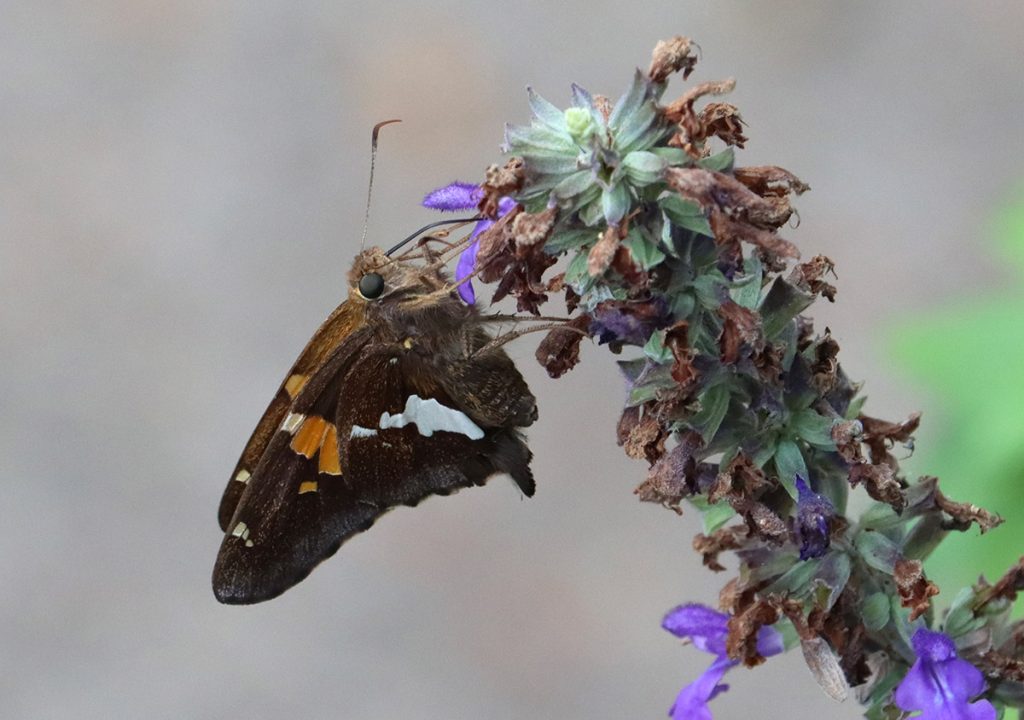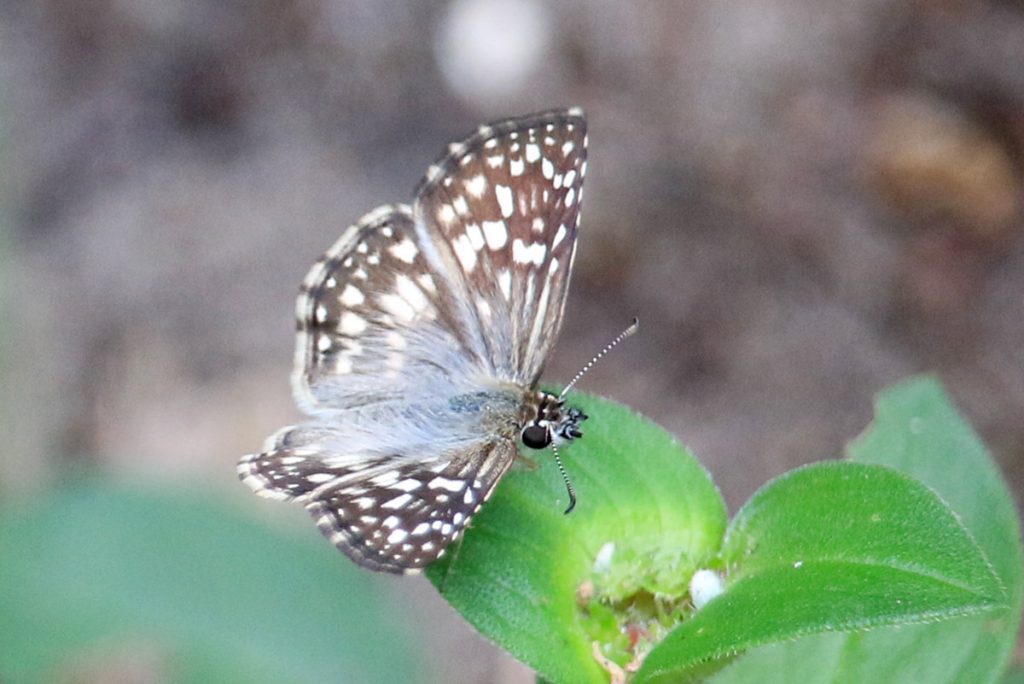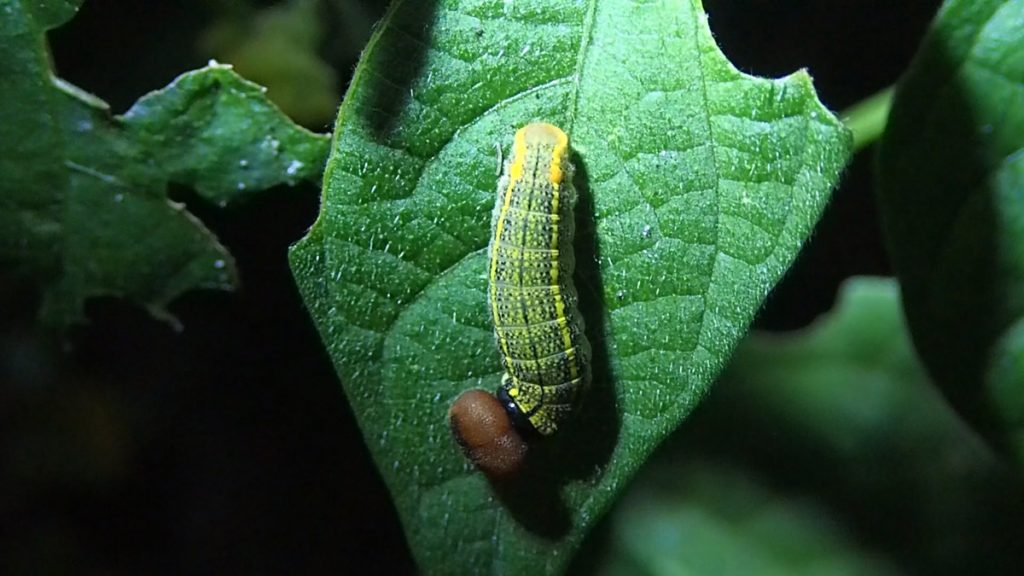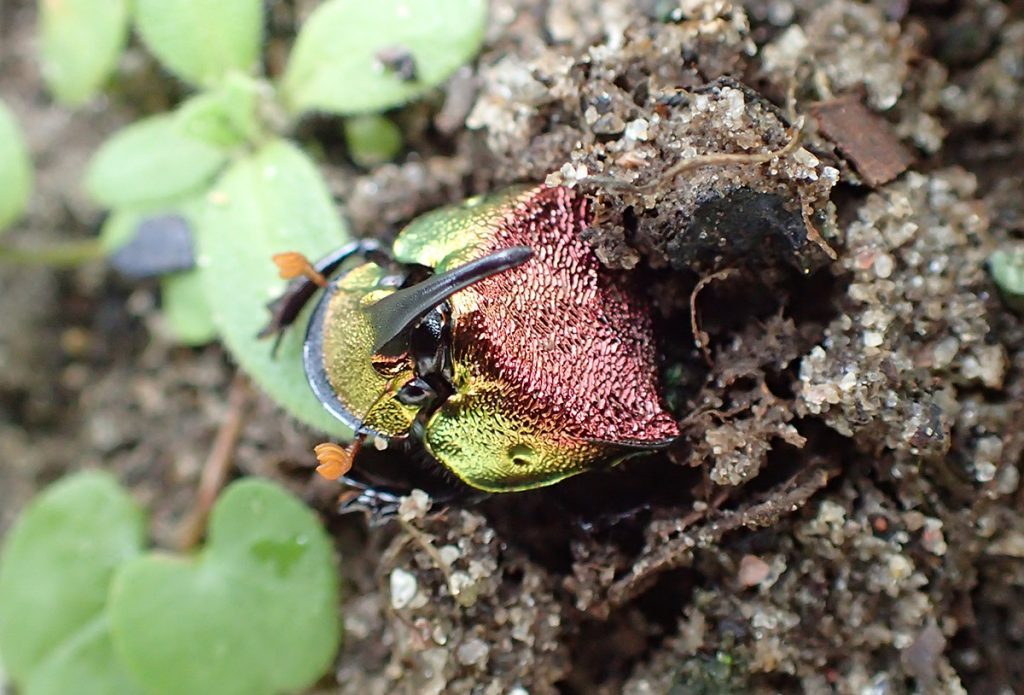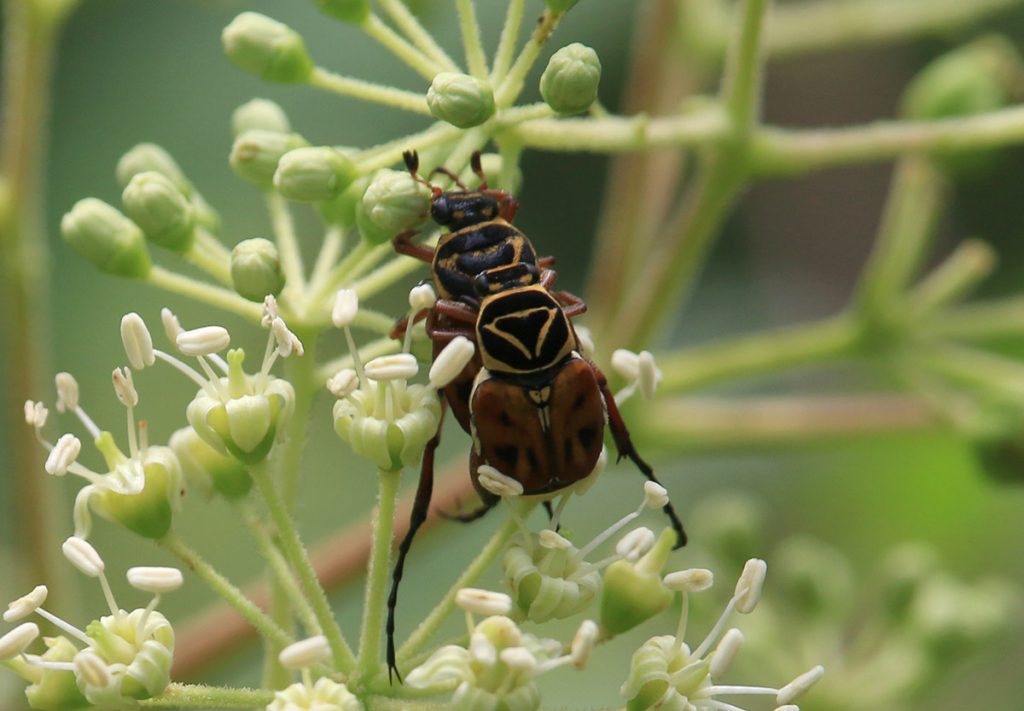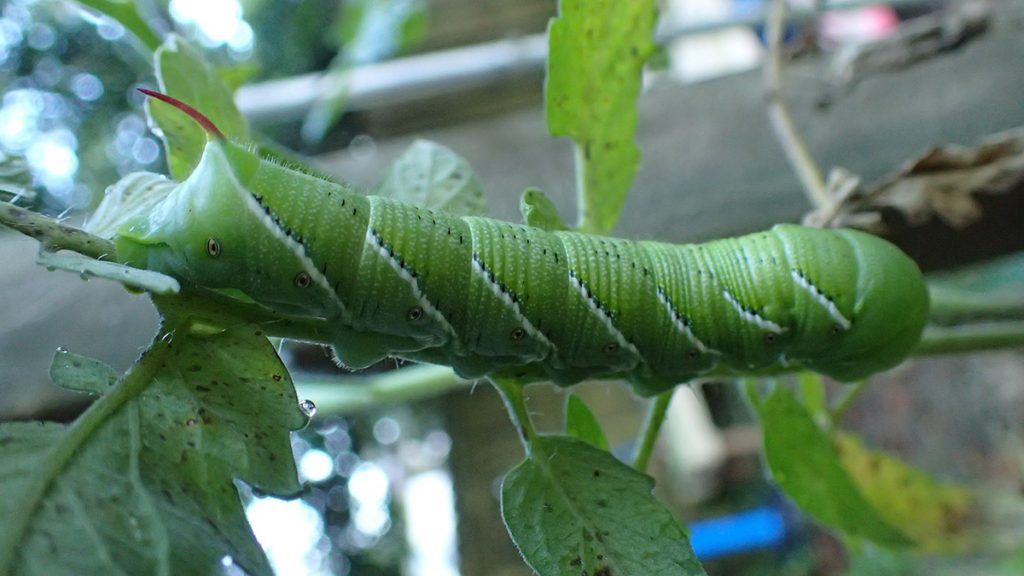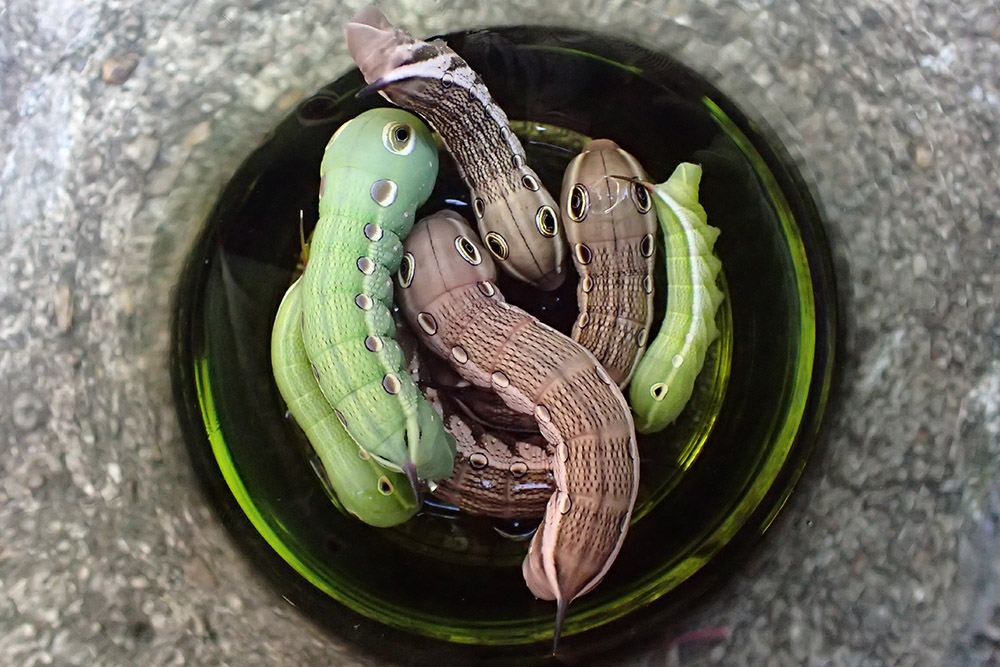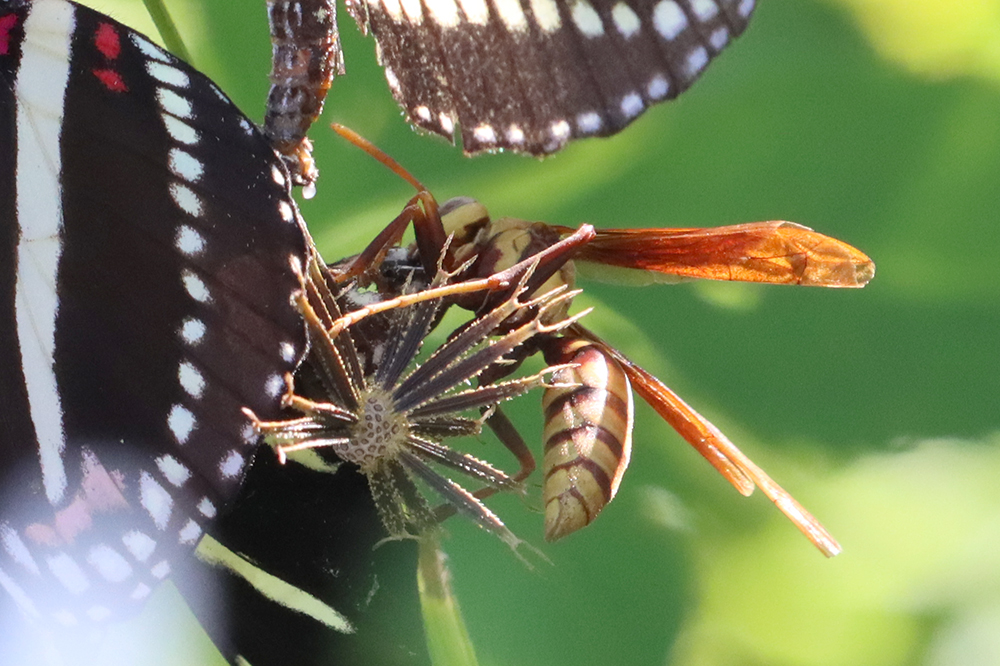Aside from insect geeks like myself, most people searching for information on wasps are looking for ways to get rid of them. Or maybe people want to identify the menacing insect flying near where they and their children are spending some outdoor time. I could be wrong, but I imagine the majority of people aren’t looking up wasps because they’re fascinated by their life cycles.
Maybe you’re here because you were looking for extermination tips, and you’re about to click away. Hear me out. The vast majority of wasp species you encounter are not aggressive. Many of them are kind of cool, and keep plant-eating insects from overgrazing your garden. They can be pretty cool. Except yellowjackets.
All insects have double lives. They have one life as larvae, and another as adults. Wasps, as larvae, eat other animals, mostly other insects. The adults are largely pollinators, but they have to feed that next generation. That’s why I see mason wasps picking little green caterpillars off of my pepper plants, or paper wasps snagging monarch caterpillars. I don’t love the monarch and bee killers, but they help create balance in my backyard ecosystem.
As much as possible, every wasp is listed with its host animal. As with our bee and fly pages, I’ll keep adding species as I see them in my yard or out in the wild here in the Florida panhandle.
A note on taxonomy
Taxonomy is how scientists classify animals, and I organized this page by family of wasp, then by subfamily or tribe, then genus, and then species.
Family Braconidae: Braconid wasps
Braconid wasps are parasitoid breeders, laying eggs in a host and developing and devouring the host insect from within. Some lay their eggs in the eggs of other insects, which hatch when the host species is in its larval stage. The best known (and liked) is the hornworm parasitoid wasp (Cotesia congregata), which parasitizes those tobacco hornworm caterpillars that sometimes eat our tomato plants.
Braconids that specialize in caterpillars inject a chemical cocktail along with their eggs. These chemicals stun the caterpillar and arrest its growth, as a metamorphosis would destroy parasites inside the insect. You may notice that Braconids have large stingers: these are ovipositors, the means by which these wasps send their eggs into another insect.
Subfamily Braconinae
Genus Atanycolus
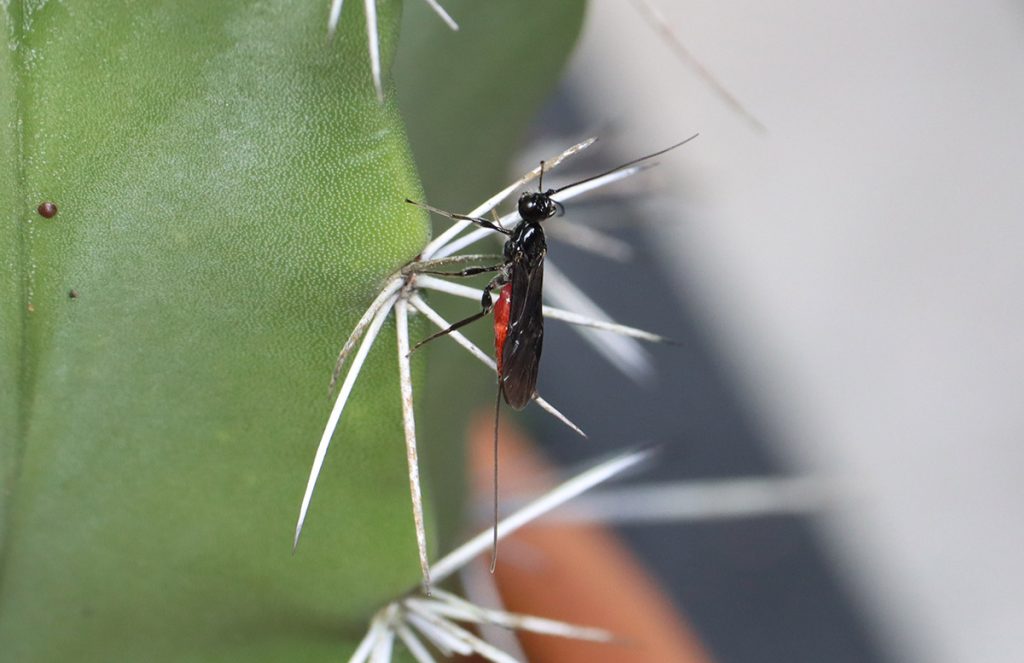
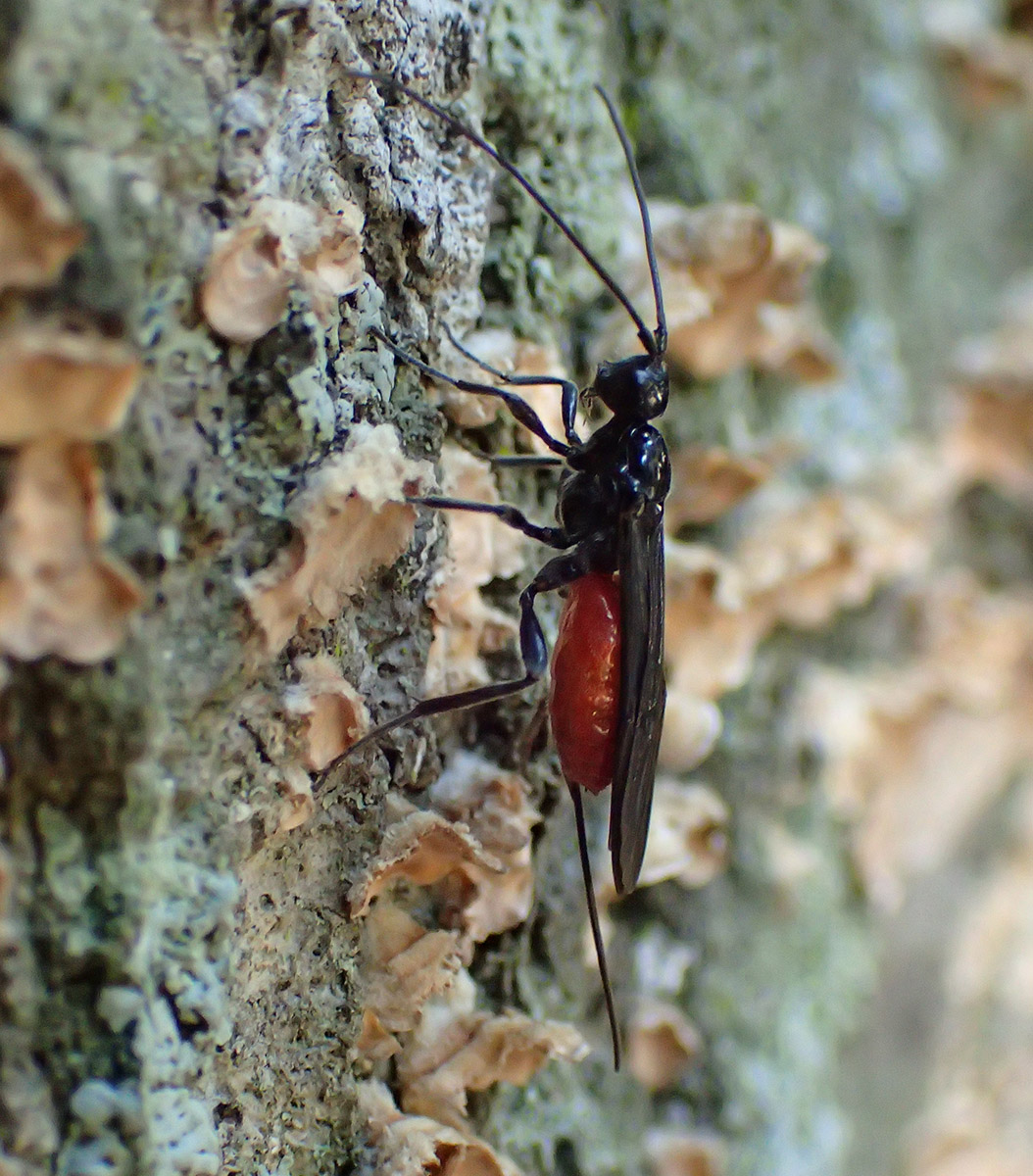
According to Bugguide, the species of wasps in this genus cannot be identified from photos. This is common in insects, to have multiple closely related species look identical to each other. Atanycolus wasps parasitize the larvae of wood-boring beetles (Buprestidae) and longhorn beetles (Cerambycidae).

Other Braconid wasps in my yard
When you scroll down to look at other wasp families, you’ll see wasps of all shapes, sizes, and colors. Braconids, and their sister family, the Ichneumon wasps, are the largest families in the order Hymenoptera (Ants, bees, wasps, and saw flies), and yet many of the species are difficult or almost impossible to tell apart without a microscope.
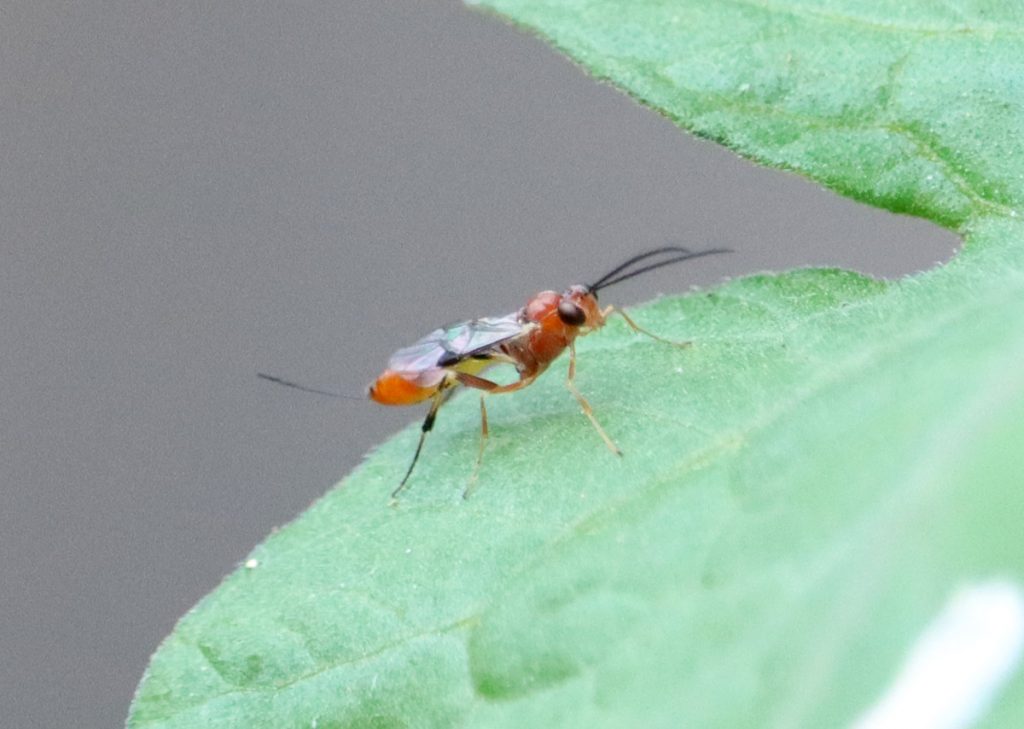
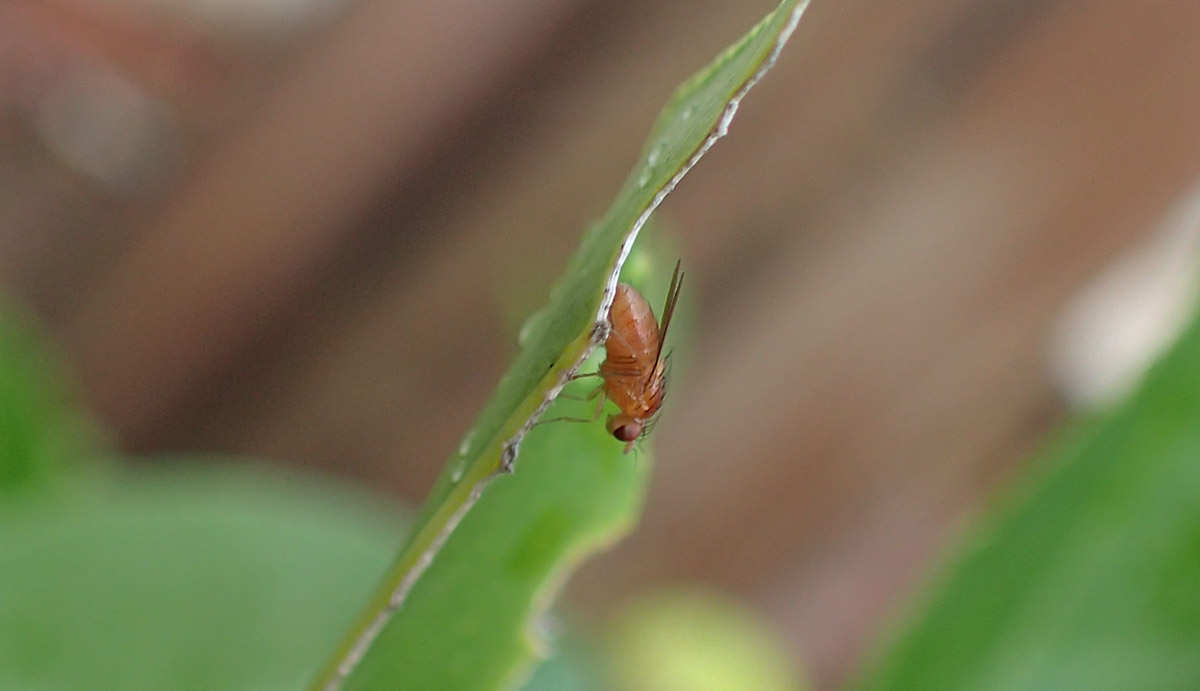
Family Chrysididae: Cuckoo wasps
Subfamily Chrysidinae
Chrysis smaragdula
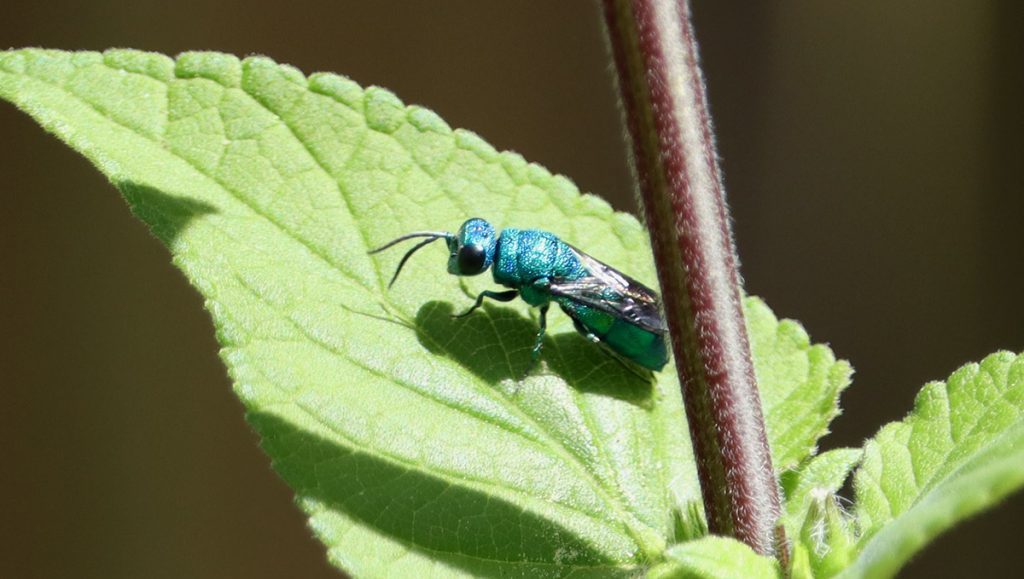
Any animal called cuckoo is a kleptoparasite: an animal that lays its egg with the eggs of another animal. Cuckoo bee and wasp species lay their eggs with specific bee and wasp species. Chrysis smaragdula specializes in four-toothed mason wasps, who, in our yard, nest in abandoned carpenter bee nests. Four-toothed masons capture caterpillars to bring back to the nest, and as they come and go, I’ll often see this wasp nearby. She’ll lay her eggs in that nest, and her offspring will eat the captured caterpillars alongside those of the mason wasp.
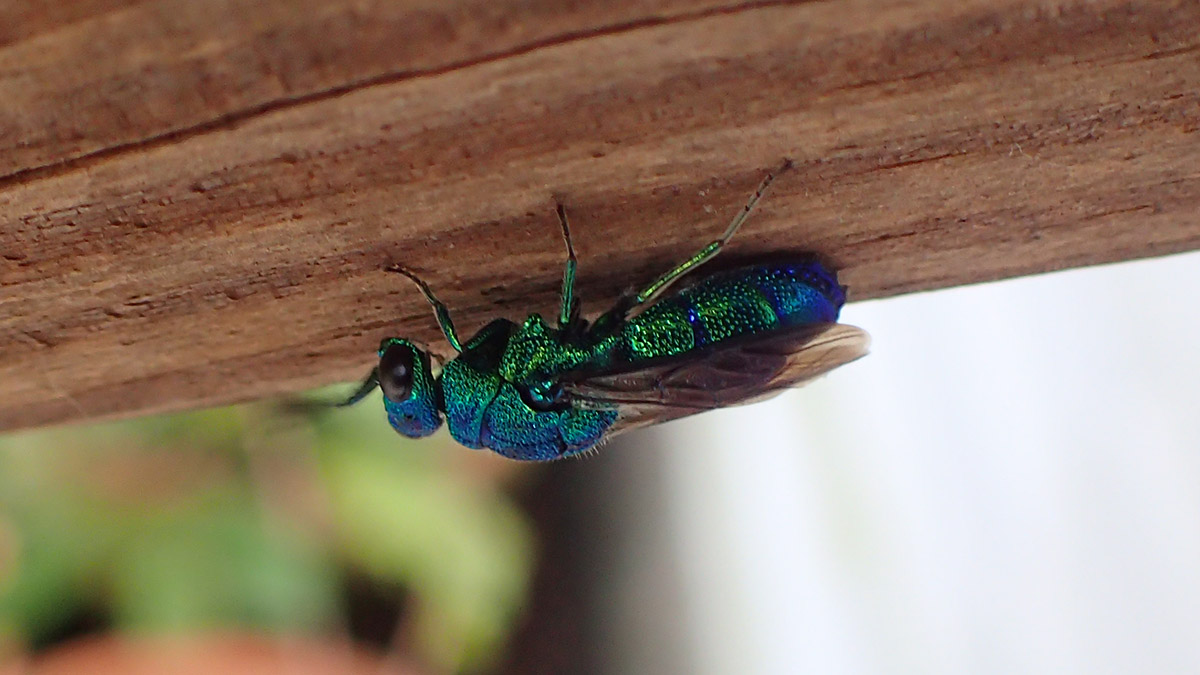
Family Crabronidae: square-headed wasps, sand wasps, and allies
Subfamily Bembicinae
Giant cicada killer (Sphecius speciosus)
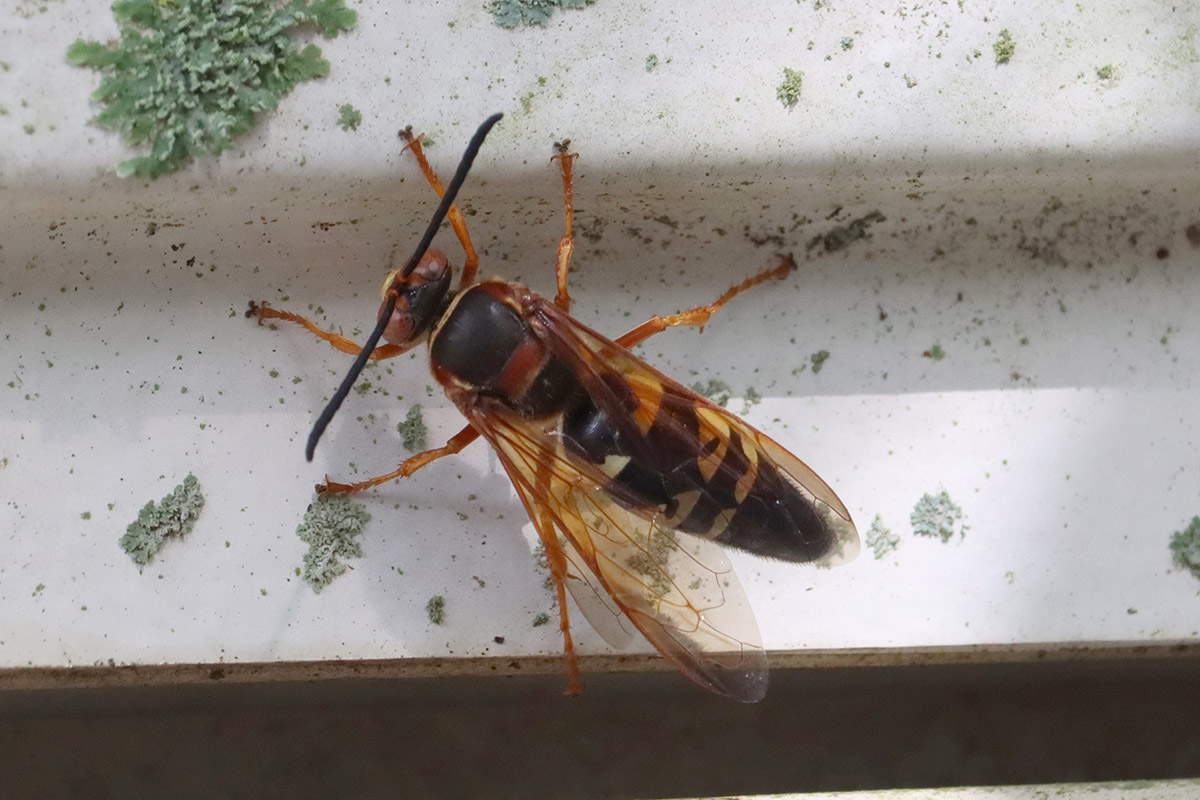
This is likely the largest wasp you’ll see in a north Florida garden. In my yard, they’re partial to dotted horsemint. It’s an impressive sight, especially if you get to see one dragging an even larger, paralyzed cicada back to its nest to feed its young. I’ll get that photo one day.
Four-banded stinkbug wasp (Bicyrtes quadrifasciatus)

The first time I saw this wasp, it was on winged loosestrife, one day after I photographed a stinkbug on the plant. Bicyrtes quadrifasciatus specializes in true bugs, an order of insects that includes stinkbugs, leaf-footed bugs, and assassin bugs, which it paralyzes and brings back to its nest.
Genus Hoplisoides

These were new to the yard in 2024, several of them routinely patrolling our partridge pea plants. They feed their larvae planthoppers, leafhoppers, and treehoppers, each of which feeds on plants.
Subfamily Philanthinae
Humped bee wolf (Philanthus gibbosus)

It’s easy to feel good about wasp species that victimize the insects that eat our plants, like grasshoppers, stinkbugs, and the caterpillars that eat our food plants (but not the ones that eat our monarchs and swallowtails). I’ve written a post or two about caterpillar killers, and how it’s not the end of the world (and may benefit the butterfly species in the long run). But how do I feel about a wasp that snags a dozen or so adult sweat bees from my garden flowers?
Because I like seeing a diverse number of insects with interlinked life cycles, it’s fine. Really. I take it as a sign of a healthy garden: I have enough bees to sustain their predators, parasites, and kleptoparasites. The more bees I have in my garden, the more I see them killed. It’s a sign of a functioning ecosystem.
Subtribe Crabronina
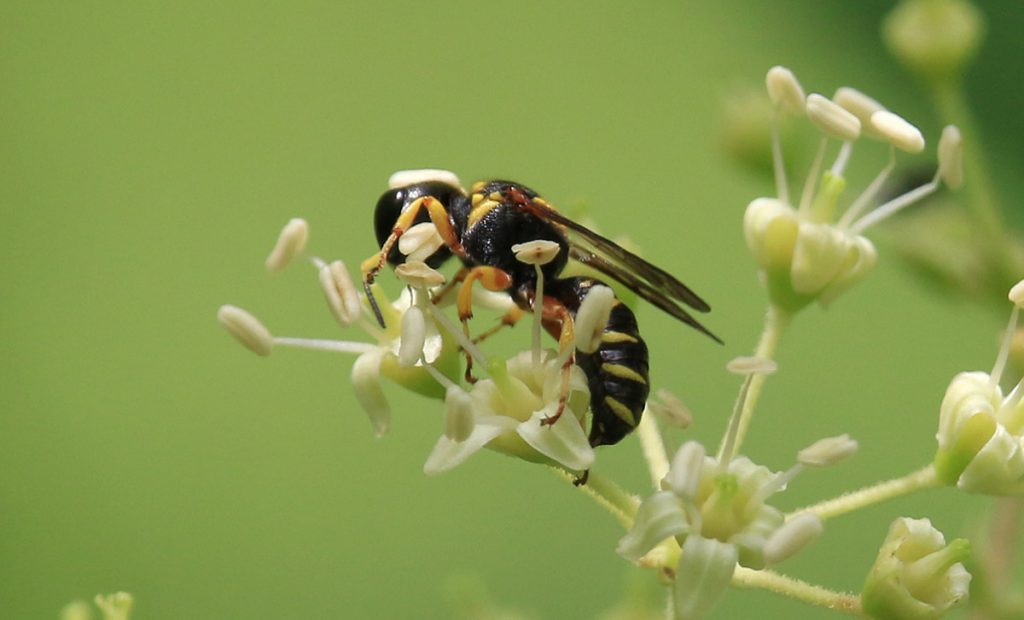
Wasps in the sub tribe Crabronina nest in rotting wood or hollow stems, while many other square-headed wasps are ground-nesters. In our post on bee nesting habitat, our interviewees recommended incorporating dead branches and other dead wood into garden landscaping, to provide nesting habitat for certain bee species. But bees are not the only insects that nest in wood.
Crabronina wasps feed their young with adult flies.
Subtribe Crabroninae
Larra bicolor

This wasp is native to South America, and was introduced in Florida to hunt down and kill another nonnative insect. Larra bicolor specializes in mole crickets, several species of which were also introduced from South America. Nonnative mole crickets cause more damage to plants than native mole crickets.
Genus Liris

Liris is another genus in subfamily Crabroninae, a ground-nester that specializes in crickets.
Subfamily Philanthinae
Genus Cerceris: Typical weevil wasps and allies
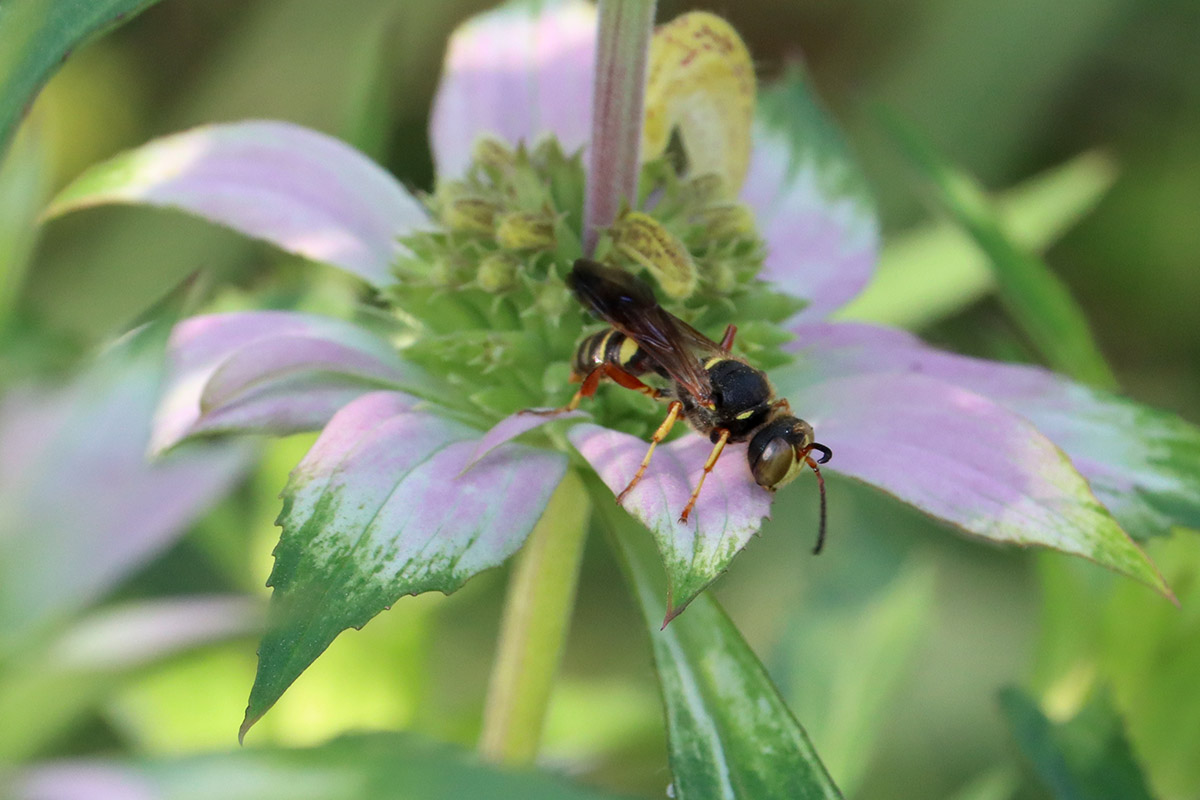
This may be Cerceris bicornuta, based on comparisons with other Cerceris wasps observed in Leon County on iNaturalist. But I’m not sure. Wasps in this genus mostly feed their larvae beetles, though some also grab bees and wasps.
I haven’t had luck making species-level iNaturalist observations of Cerceris wasps, a genus with several lookalike species.


Family Ichneumonidae: Ichneumon wasps
Like Braconids, Ichneumon wasps are parasitic breeders.
Subfamily Ichneumoninae
Limonethe maurator
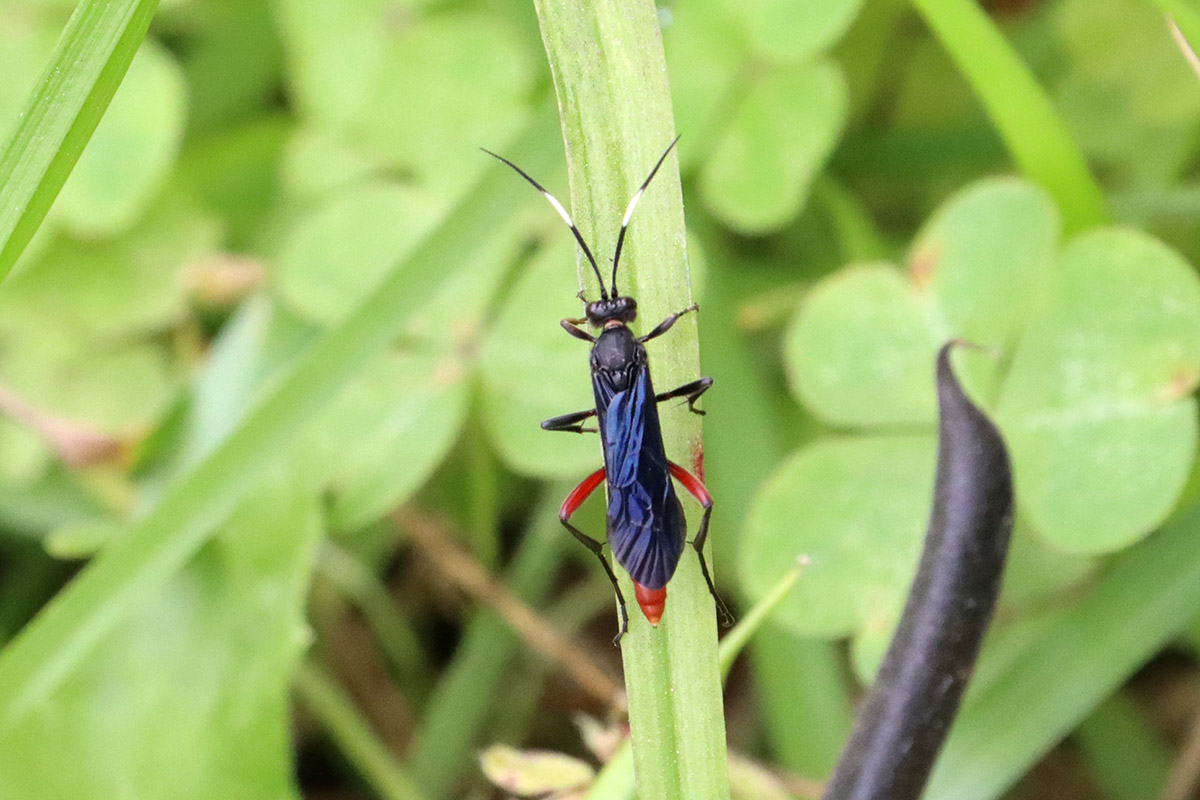
The larvae of this wasp are parasites on morning cloak and painted lady butterflies. Like all Ichneumoninae, they lay eggs on caterpillars or chrysalises, which the larvae then feed upon. Adults emerge from the chrysalises of those butterflies (the butterflies do not emerge).
According to Bugguide, adult wasps in subfamily Ichneumoninae feed not on flowers, but on aphid honeydew or foliage.
Trogomorpha trogiformis
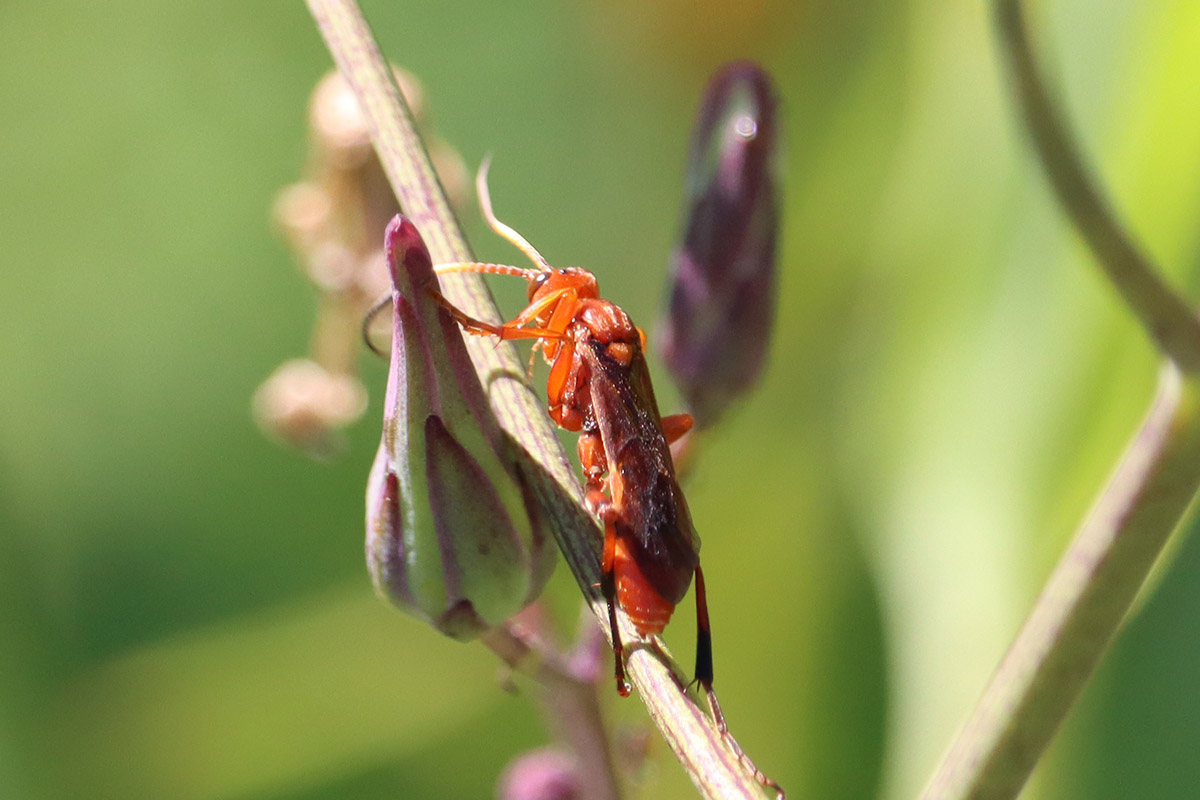
Another Ichneumoninae, this one specializes in skipper butterfly larvae and pupae. Skippers are common butterflies that many people confuse with moths. Here are a few you might see in your garden:
Other Ichneumonidae in the garden
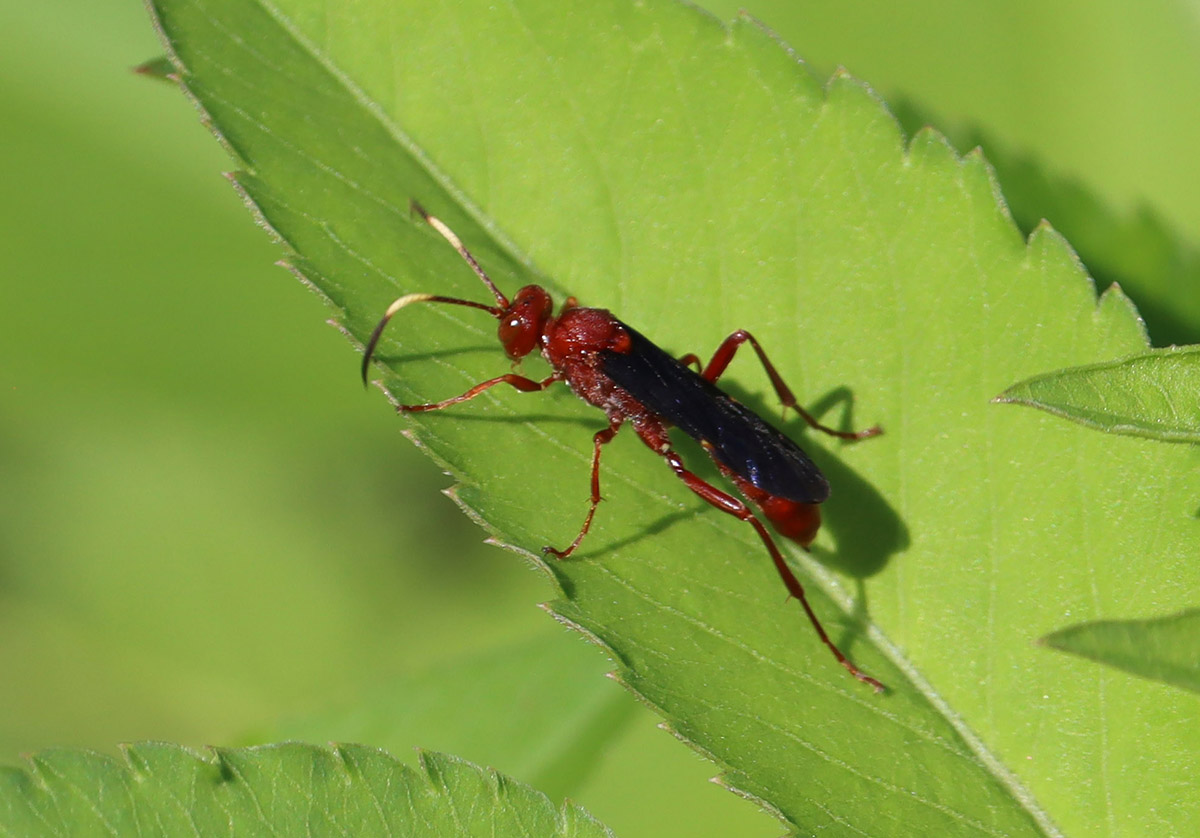
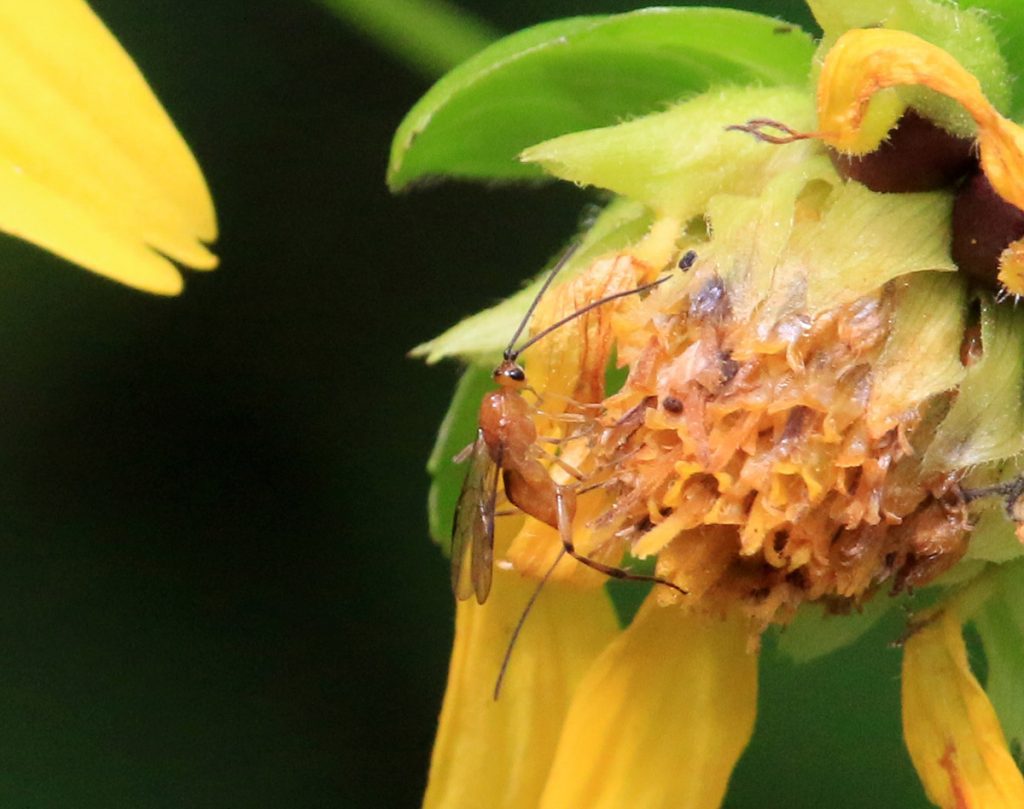
Family Pompilidae: Spider wasps
Spider wasps are predators that feed on other predators – specifically, spiders. Pompilidae paralyze a spider and lay an egg on it, which then hatch and devour the spider from within. Some groups of spiders bring the spider back to their nest, while others leave the spider in place.
Subfamily Pepsinae
Eastern tawny-horned spider wasp (Entypus unifasciatus)
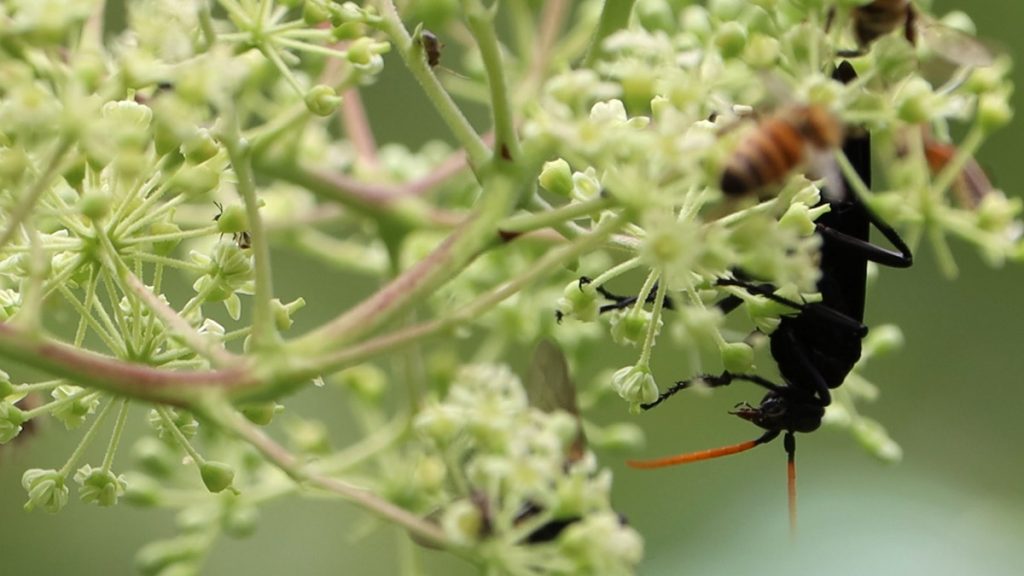
The eastern tawny-horned spider wasp has been known to parasitize wolf spiders, dragging the large, scary-looking predators back to their nests for their larvae to consume. Seriously, take a look at a wolf spider. This is the prey of the wasp we see above.
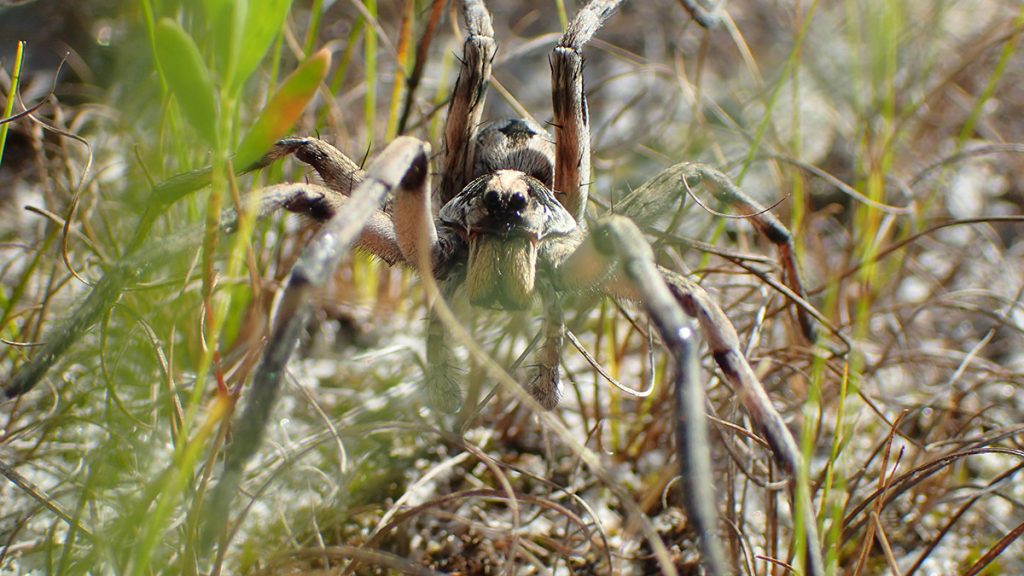
Subfamily Pompilinae
Psorthaspis legata
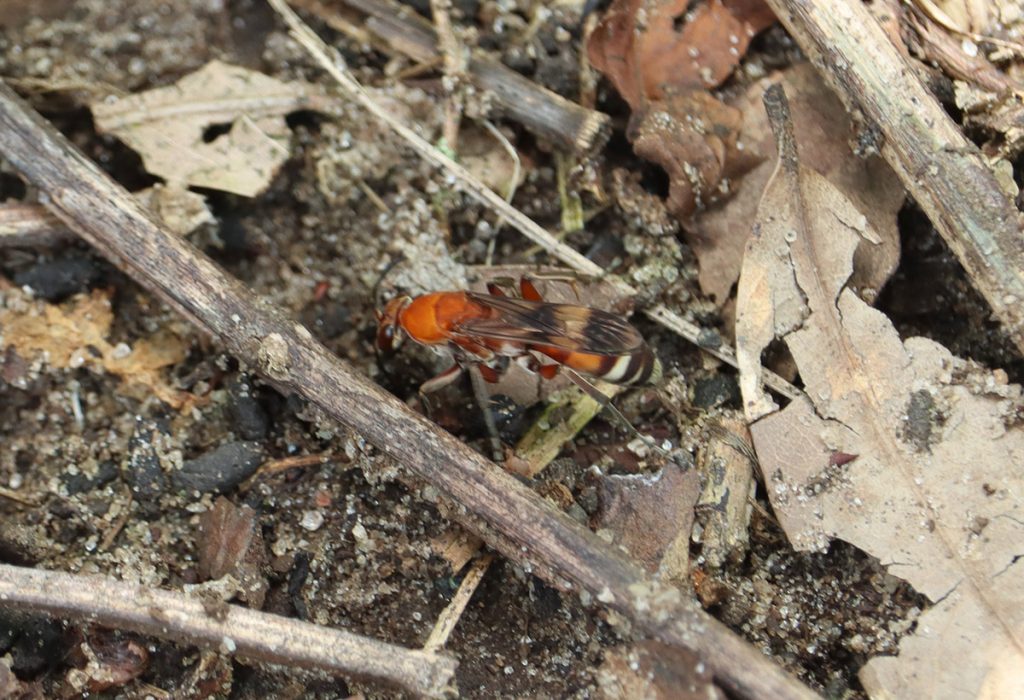
This wasp specializes in trapdoor spiders. Trapdoor spiders create a burrow with a hatch made of soil or vegetation, under which they await passing invertebrates. After they snag their prey, they may discard the remains out of a second burrow entrance. When I uploaded images of this wasp to iNaturalist, a biologist thought they saw beetle remains and thought that it was likely trying to enter the “back door” of the spider nest to attack it.
Rusty spider wasp (Tachypompilus ferrugineus)
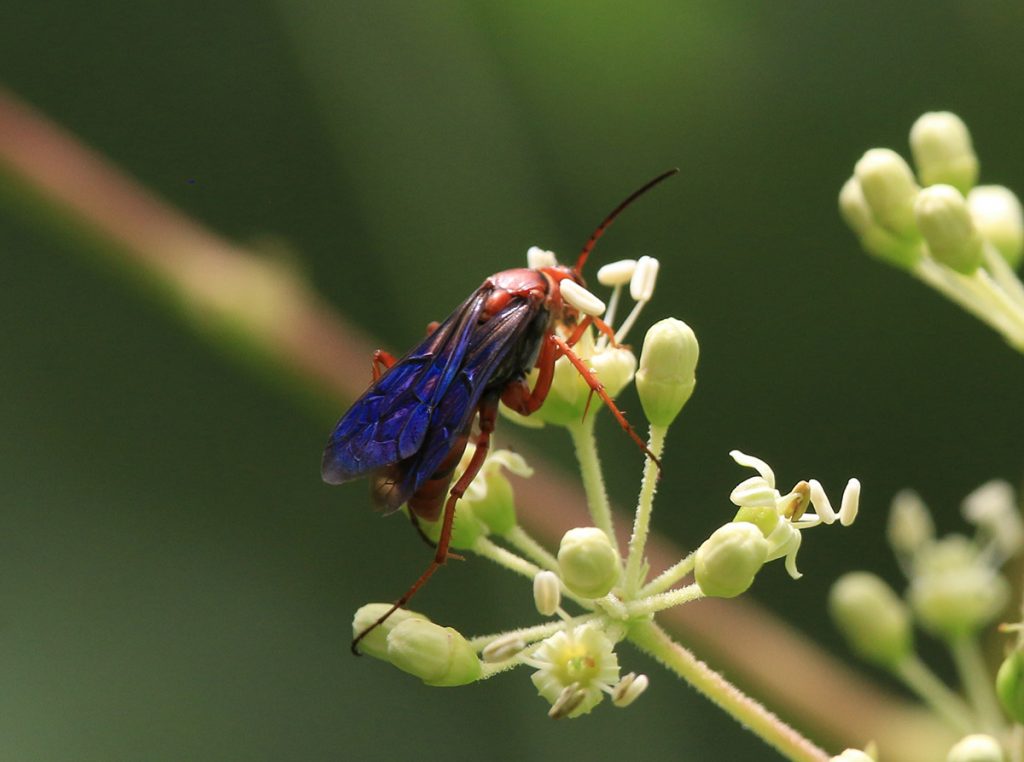
Another spider that drags wolf spiders back to their nests. You may notice that three of the spider wasps on this page are nectaring on devil’s walkingstick; these images are all from the same day. Walkingstick is a small tree that blooms late in summer, just before dotted horsemint blooms. Both bloom for a few weeks and attract a number of different bee and wasp species.
Genus Anoplius
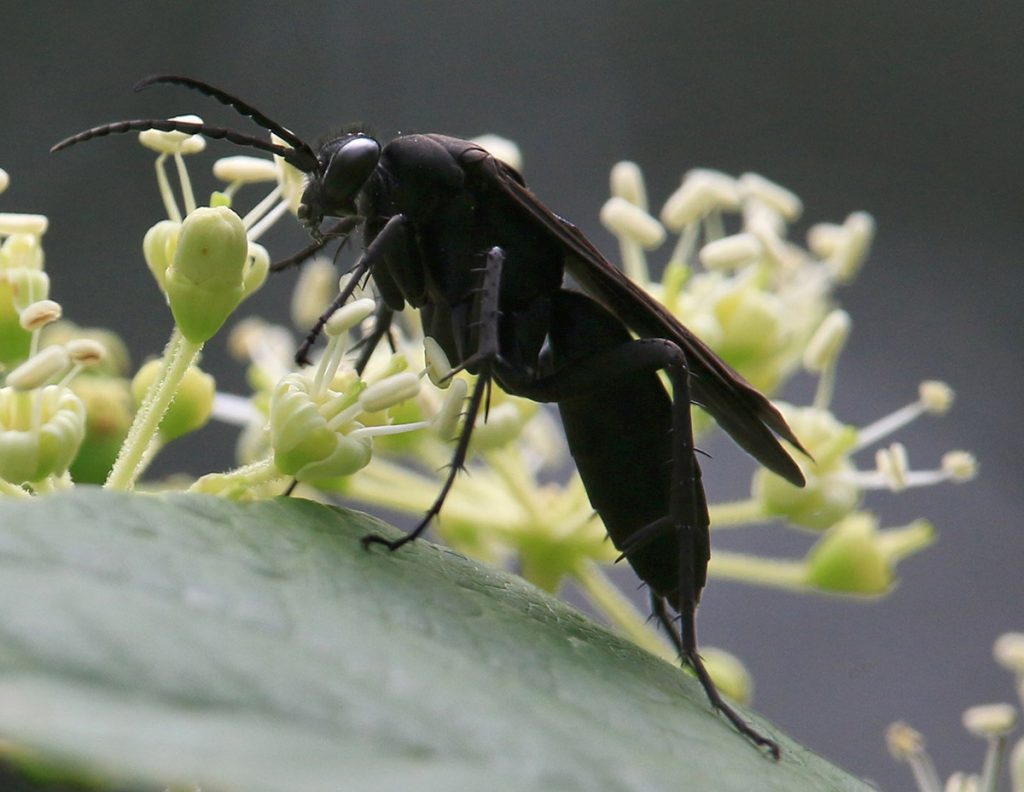
Wasps in the genus Anoplius are yet another group that victimizes wolf spiders.
Scoliidae: Scoliid wasps
Scoliids parasitize scarab beetle larvae, digging into their below-ground nests to paralyze and lay eggs on them. Scarabs are ground nesters, and include dung beetles as well as several species of pollinating beetles. Pollinators and insects that remove waste are generally considered beneficial, and yet their larvae may damage plant roots while feeding. Scoliid wasps are a check on these larvae.
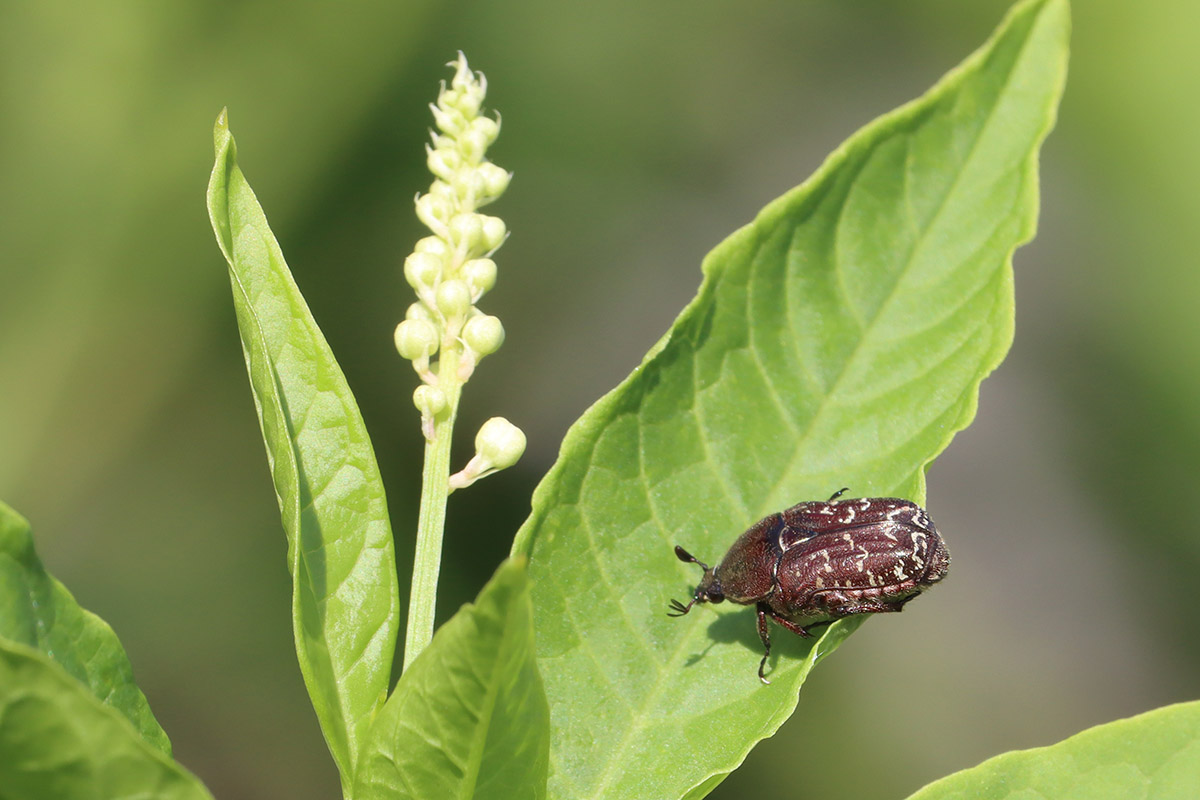
Tribe Campsomerini
Feather-legged scoliid wasp (Dielis plumipes)
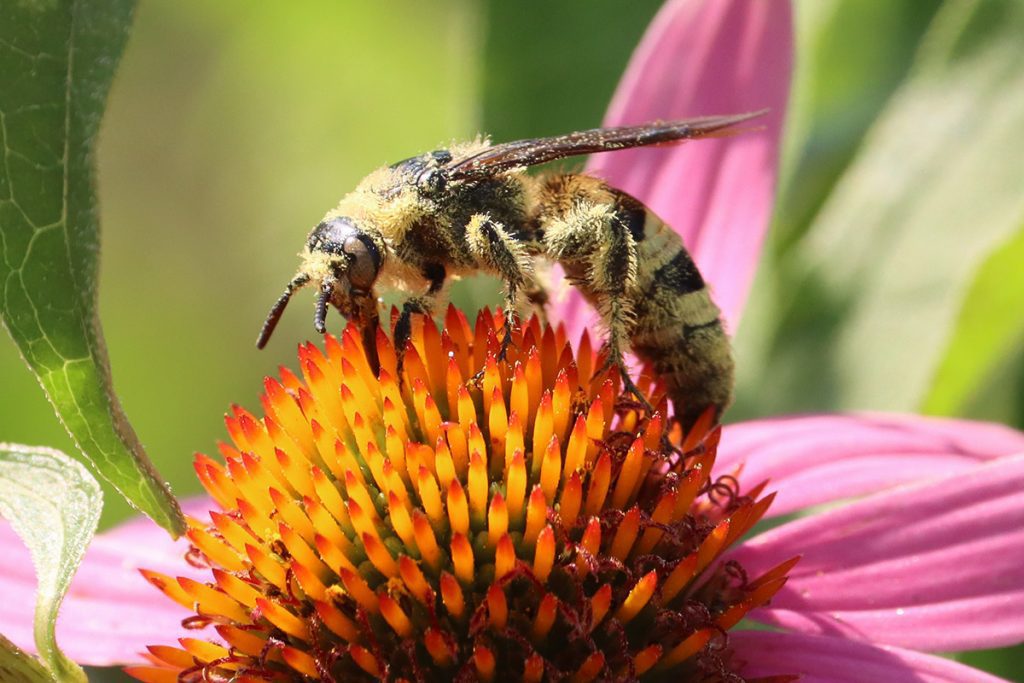
This is most commonly seen scoliid wasp in our area.
Large four-spotted scoliid wasp (Pygodasis quadrimaculata)
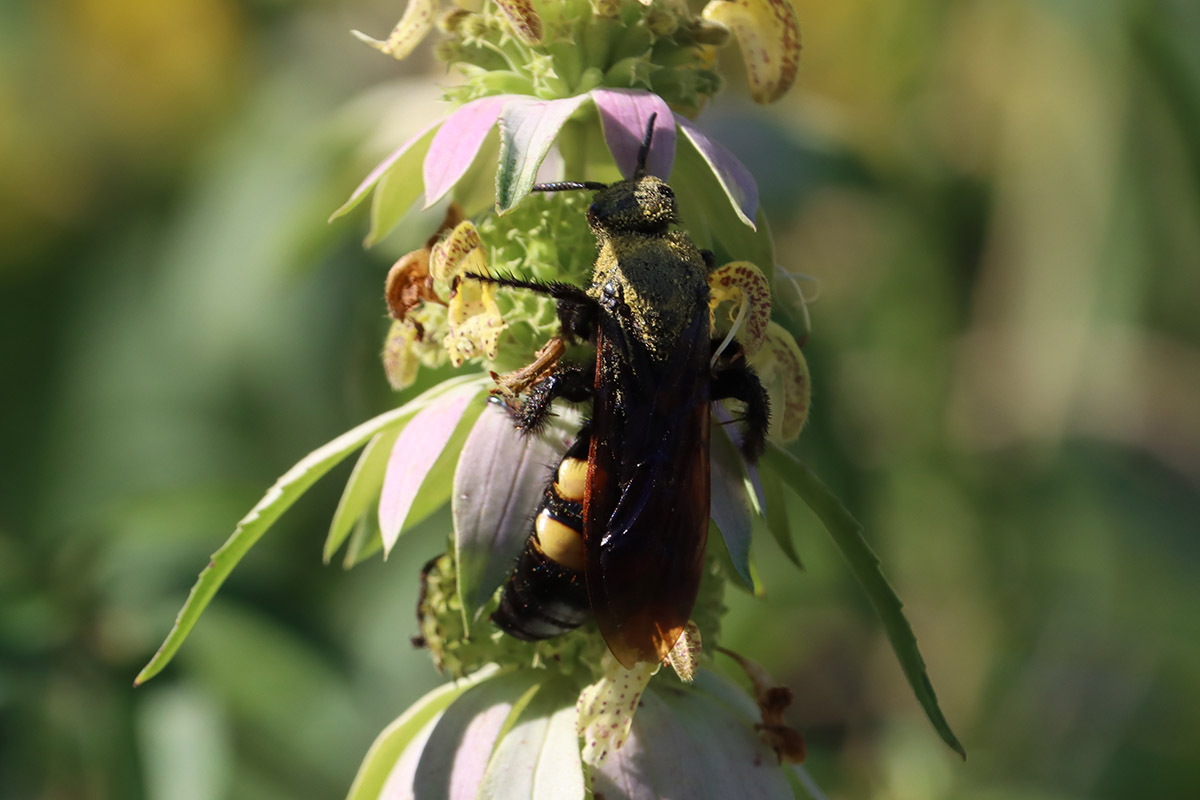
The largest scoliid wasp in our area, not to be confused with the cicada killer, another large, striped wasp. It also has a similar pattern to the smaller noble scoliid wasp.
Tribe Scoliini
Noble scoliid wasp (Scolia nobilitata)
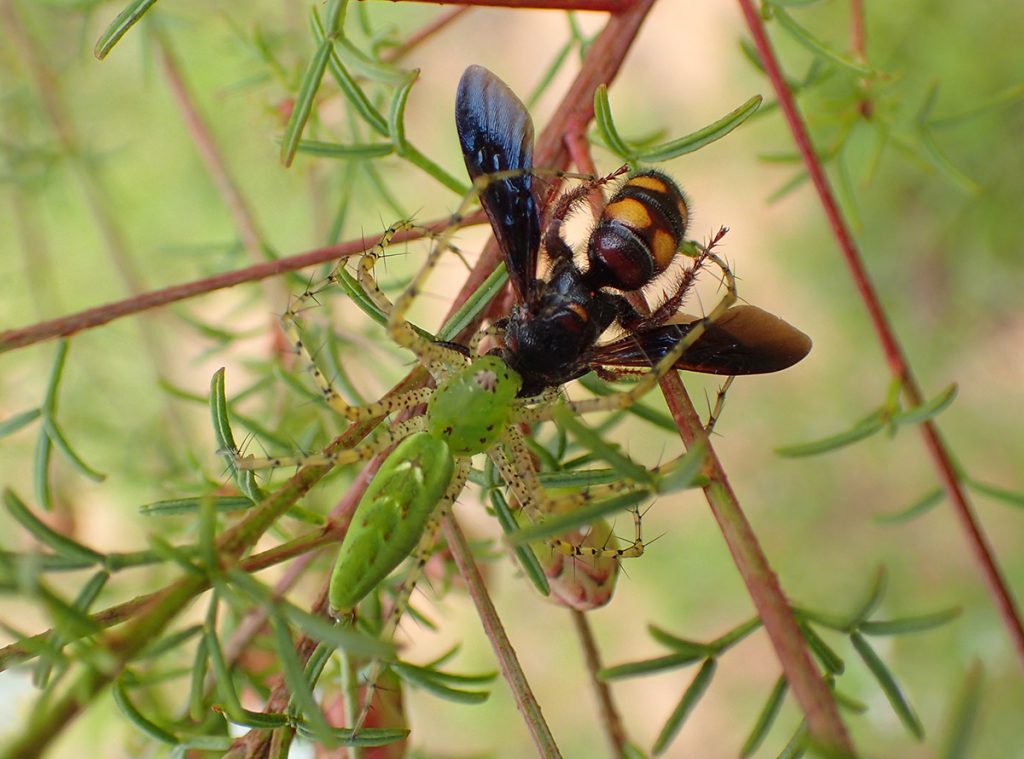
Aside from the size (four-spotted scoliid wasps can be almost twice as large), one way to tell the noble scoliid from its larger cousin is that is has red legs, while the large four-spotted scoliid has black legs.
Two spotted scoliid wasp (Scolia dubia ssp. dubia)
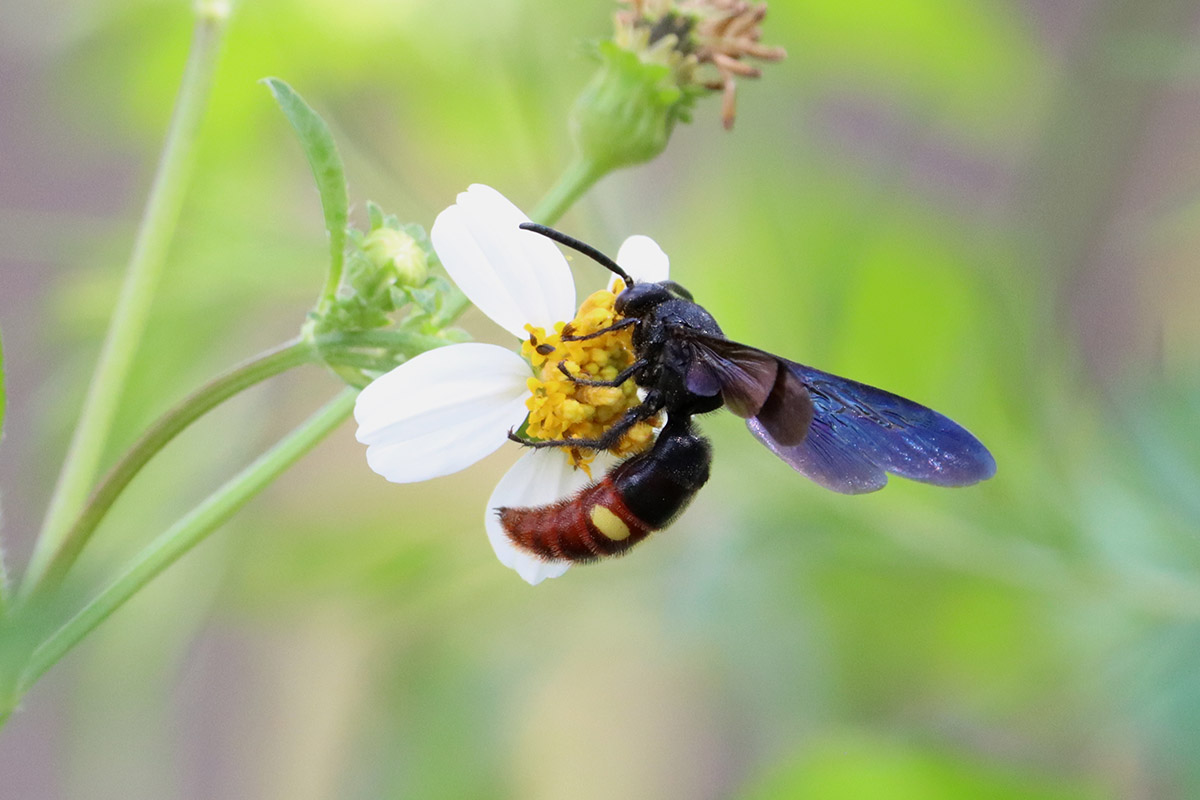
blue-winged scoliid wasp. On Bidens alba.
To me, this is the prettiest of the scoliids. In researching the host species for scoliid larvae, this is the only one that has prey listed that are more specific than scarab beetles. According to bugguide, blue-winged scoliids parasitize June beetles and nonnative Japanese beetles.
Family Sphecidae: Thread-waisted Wasps
The larvae of this family feed on a variety of arthropods, including spiders and insects.
Subfamily Ammophilinae
Gold-marked thread-waisted wasp (Eremnophila aureonotata)
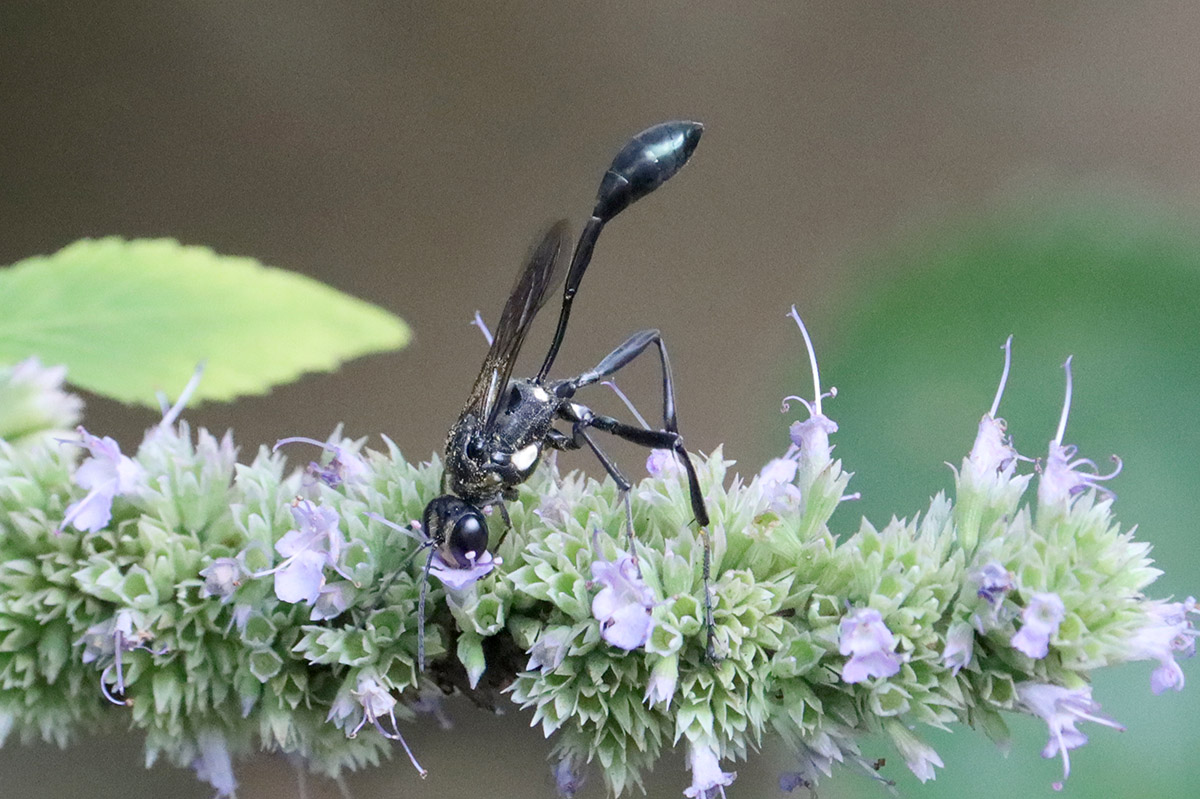
This wasp feeds on the caterpillars of various moth and butterfly species, includeing owlet moths, prominent moths, hawk moths, and skipper butterflies. Hawk moths, to me, are cool pollinators, but their larvae can be trouble. I’m talking, of course, of the tobacco hornworm that can decimate our tomato plants.
Thread-waisted sand wasps (Genus Ammophila)
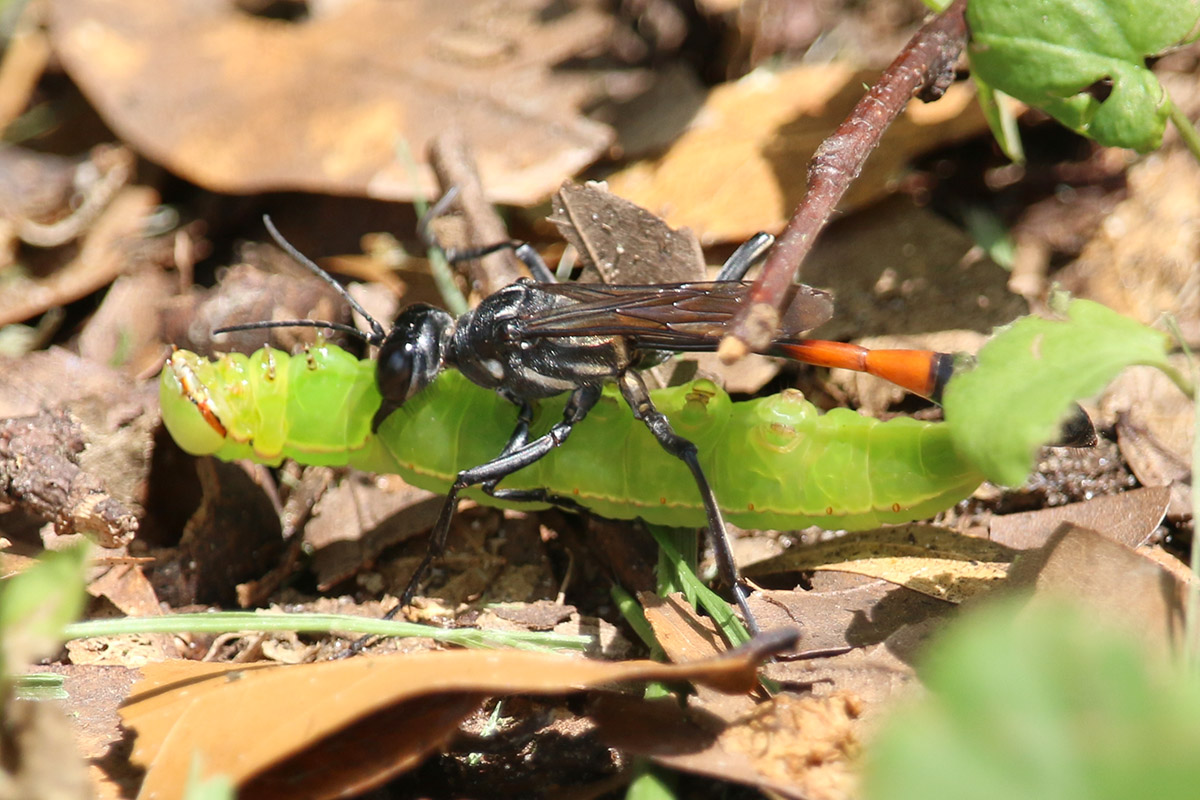
This is a genus of wasp I commonly see both in the forest and in my yard. It’s also one I’ve been lucky to be able to photograph taking part in different activities. The one above was taking a caterpillar back to its nest to feed its young. Ammophila larvae eat caterpillars and sawfly larvae.

Here, in the forest, I see one next to what might be its nest.
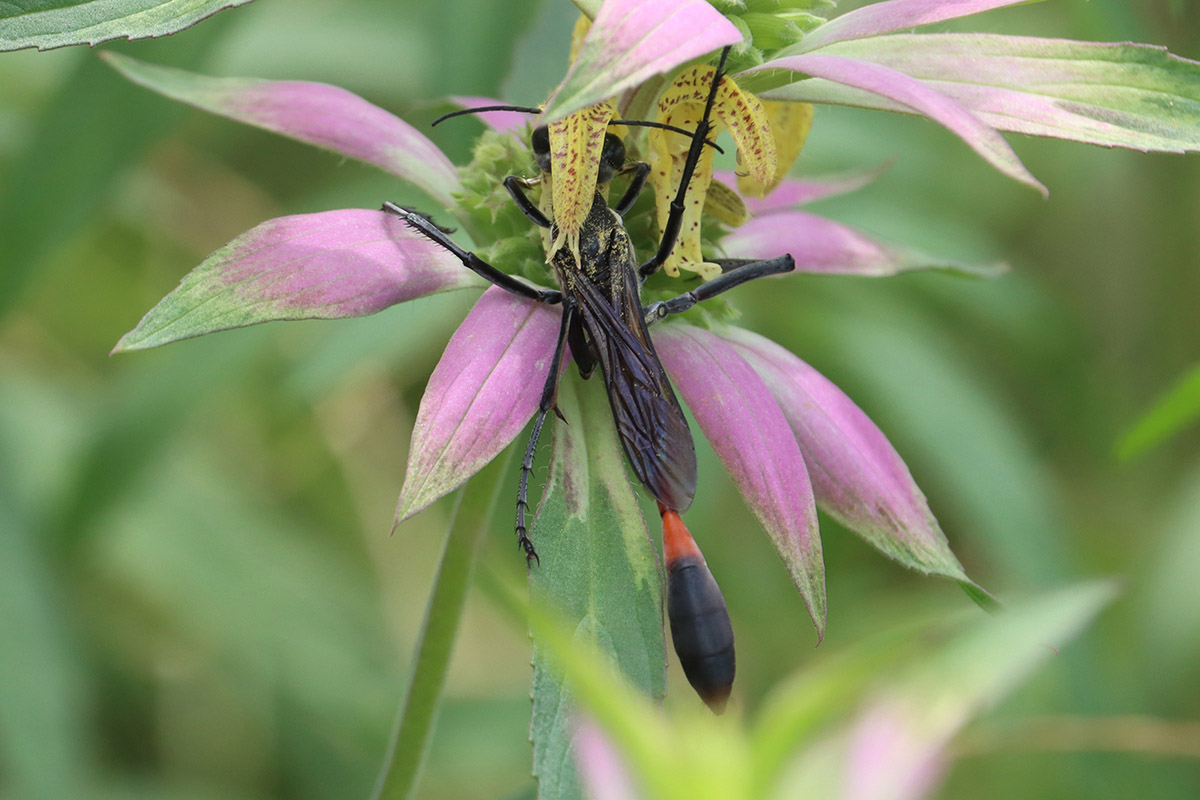
And here is a thread-waisted sand wasp taking nectar from dotted horsemint (aka spotted beebalm). As I said earlier, this and devil’s walkingstick are wasp magnets. I see a lot of bees on beebalm, but nothing that wasn’t already in the yard before it bloomed (though its bloom times out with the second, larger brood of brown-winged striped sweat bees exploding into the yard). Waspbalm might be a more appropriate name for the flower, though not a highly marketable one.
Subfamily Sceliphrinae: mud dauber wasps and allies
Aztec/ Zimmerman’s mud-dauber Wasp (Chalybion zimmermanni)
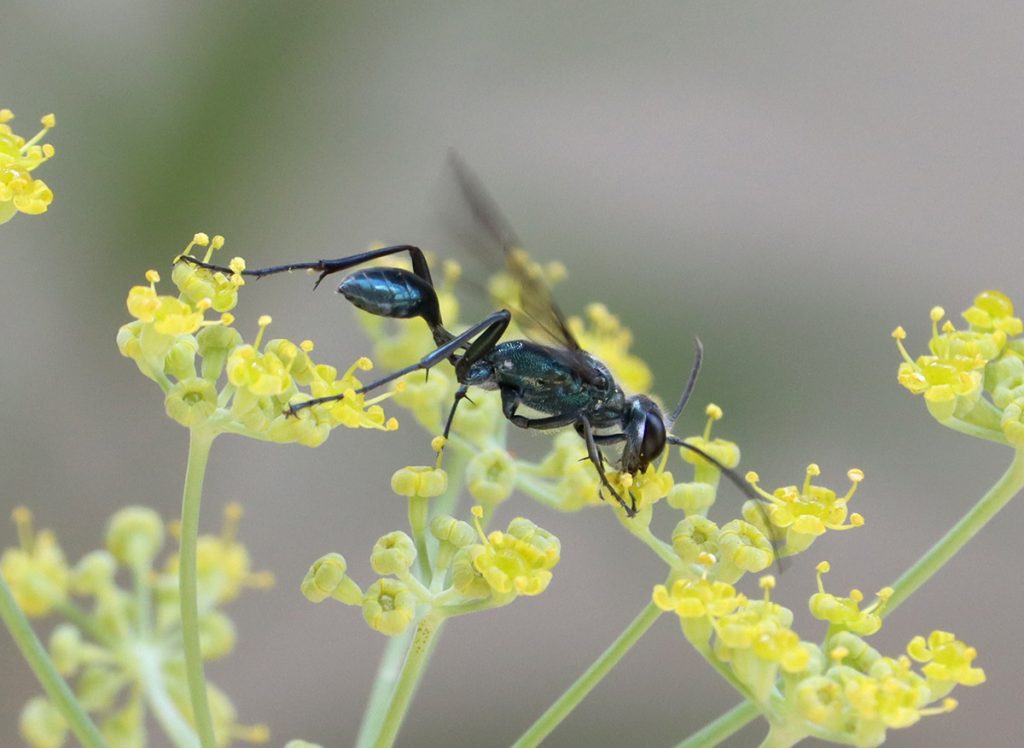
Mud daubers create nest structures out of mud. If you were to crack one open, you’d find spiders, which is what they feed their larvae.
Podium rufipes
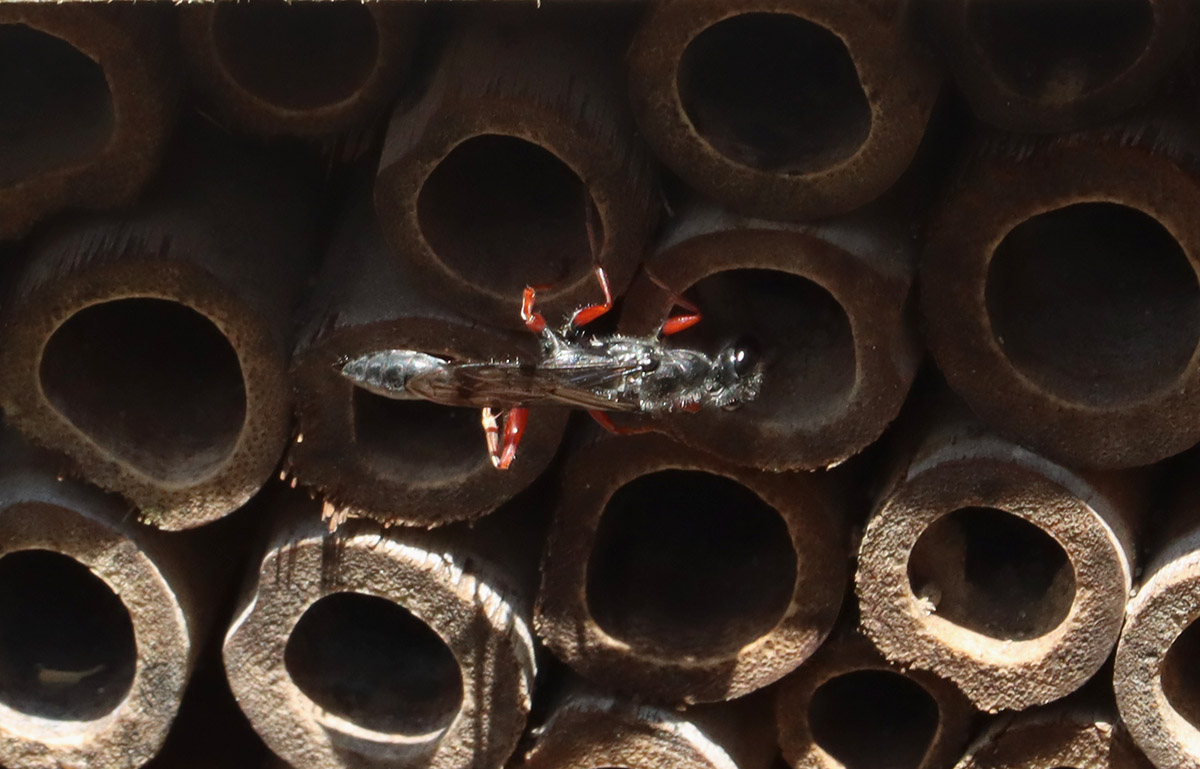
This wasp feeds its larvae cockroaches, and nests in wood, often where other wasps have nested. Many people buy bee nesting houses like the one you see above. We don’t have many species of mason bee in north Florida, though I have had one use this box. We have many more species of mason wasps, which we’ll see below. They used this box, and perhaps Podium rufipes took over one of their nests.
Subfamily Sphecinae
Genus Sphex: Digger wasps
Digger wasps feed their larvae Orthopterans, an order of insects that includes grasshoppers, crickets, katydids, and locusts.
Great golden digger wasp (Sphex ichneumoneus)
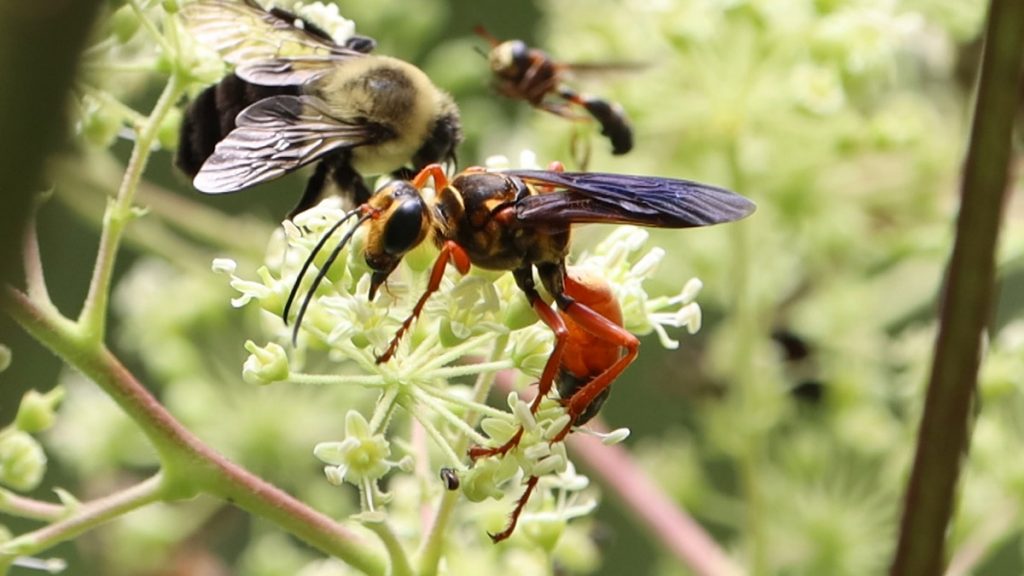
This wasp carries orthopterans back to its underground nest, placing one in each cell, each cell receiving one egg.
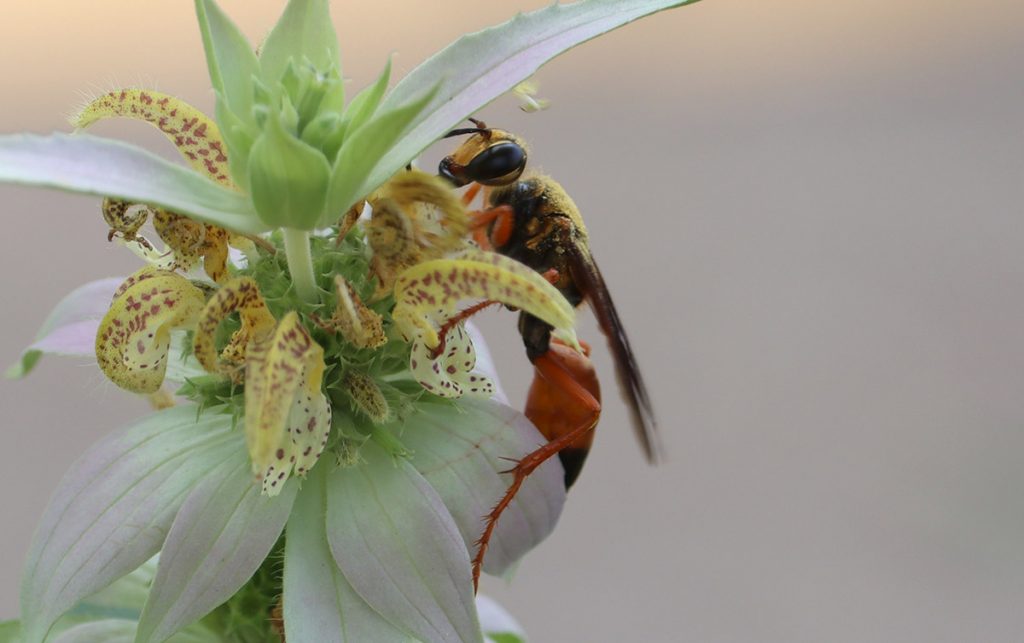
Great black digger wasp (Sphex pensylvanicus)
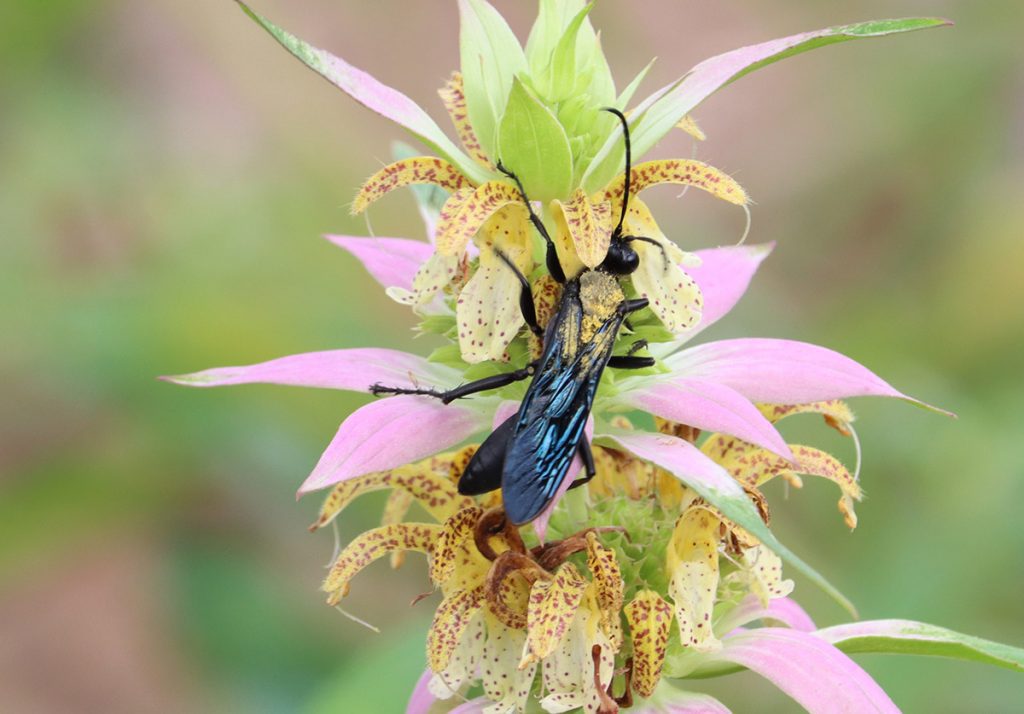
This wasp speficially hunts katydids.
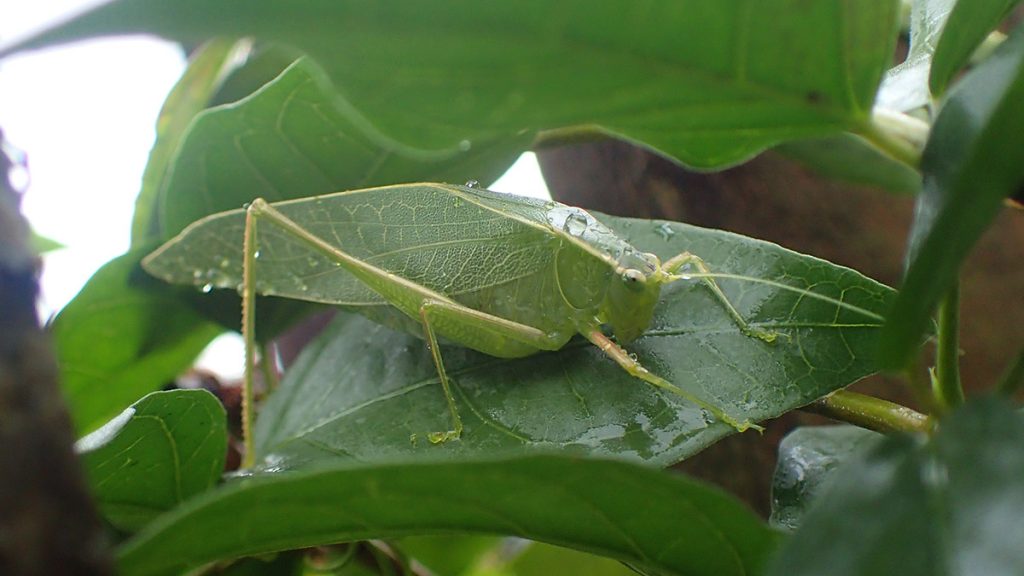
Thynnidae: Thinnid Flower Wasps
Myzinum obscurum

Wasps in the genus Myzinum feed their larvae scarab beetle grubs.
Family Vespidae: Hornets, Paper Wasps, Potter Wasps, and Allies
Subfamily Eumeninae: Potter and Mason Wasps
Mason wasps nest mostly in wood borings such as abandoned carpenter bee nests, sealed with a cement made from sand and saliva. Potter wasps build structures from this sand. They mainly feed their larvae moth caterpillars.
Genus Euodynerus
Euodynerus hidalgo
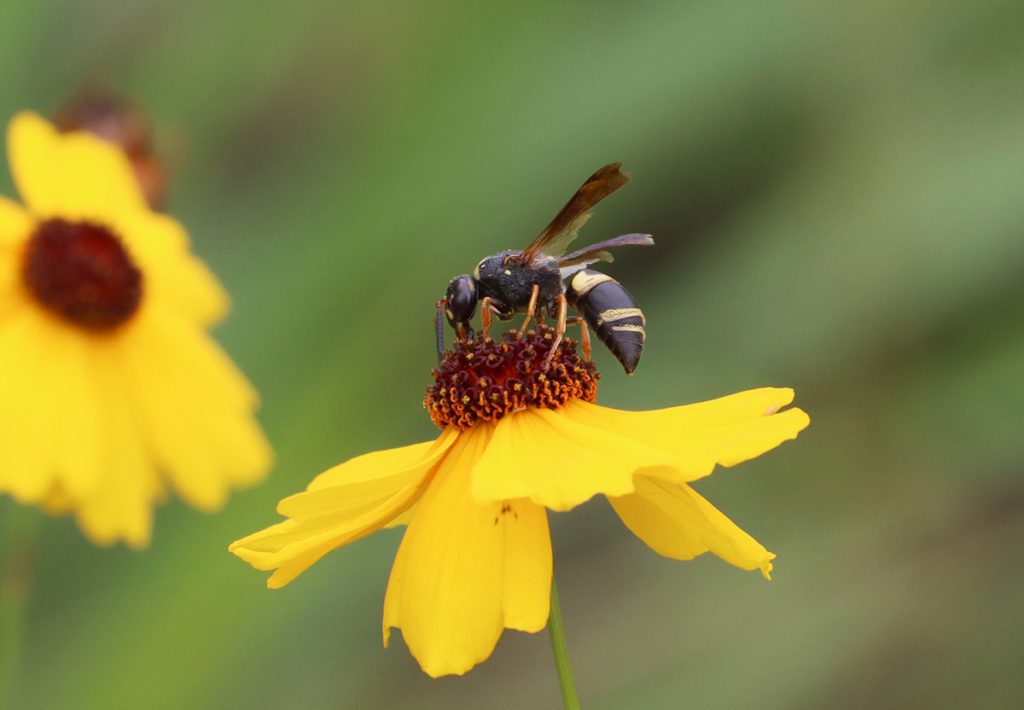
This wasp is a ground nester, and occasionally uses mud dauber or paper wasp nests.
Complex Euodynerus foraminatus

This was a wasp that stumped biologists on iNaturalist for a couple years, because it didn’t look like any wasp that was supposed to be in north Florida. Mason wasps are black with different combinations of red, white, or yellow stripes, and this one didn’t have a combination that exactly matched any known species.
One year, these wasps were identified as complex Euodynerus foraminatus. A species complex is a group of closely related plants or animals that share characteristics but that are difficult to separate into distinct species. Sometimes, biologists are able to name individual species after gathering more information, including DNA.
Above, we see a wasp gathering sediment as mason wasps often do to seal a nest. Below, we see several of the wasps perhaps trying to find mates. They started coming from behind the fence post, which in our yard are full of carpenter bee nests that turn into mason wasp nests.
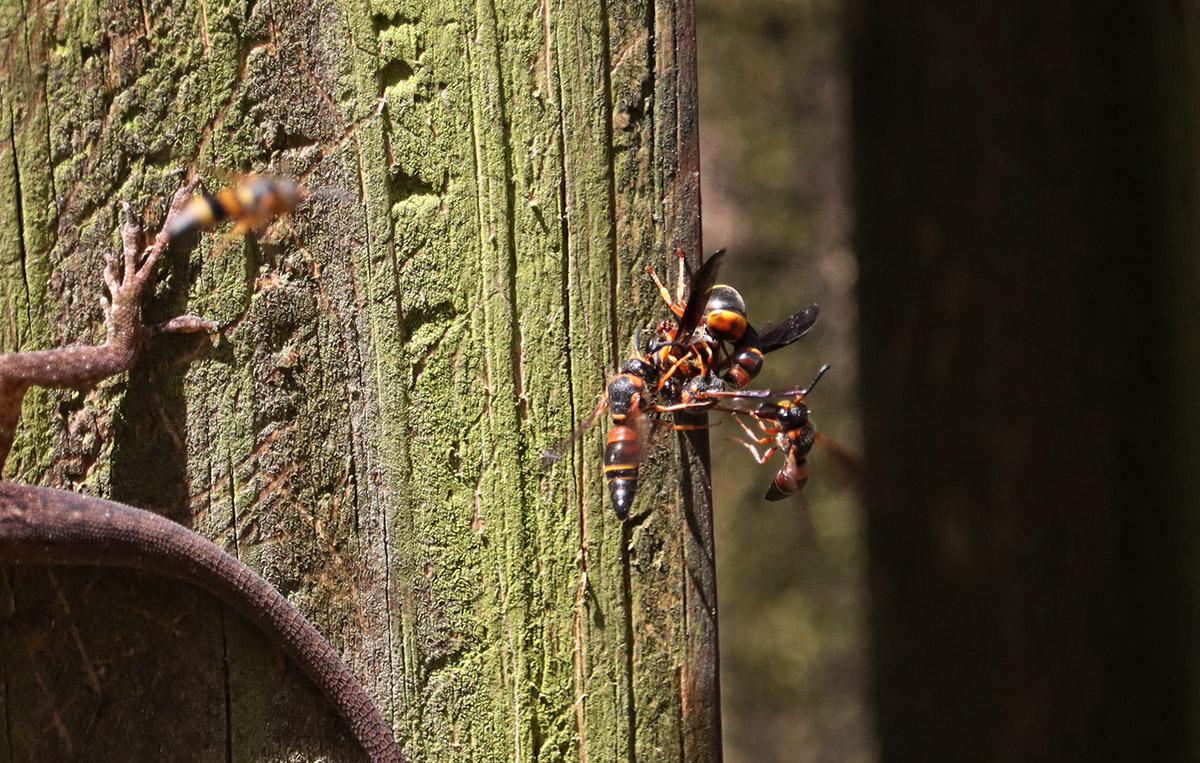
Below is a good look at the wasp as it rests on a leaf.
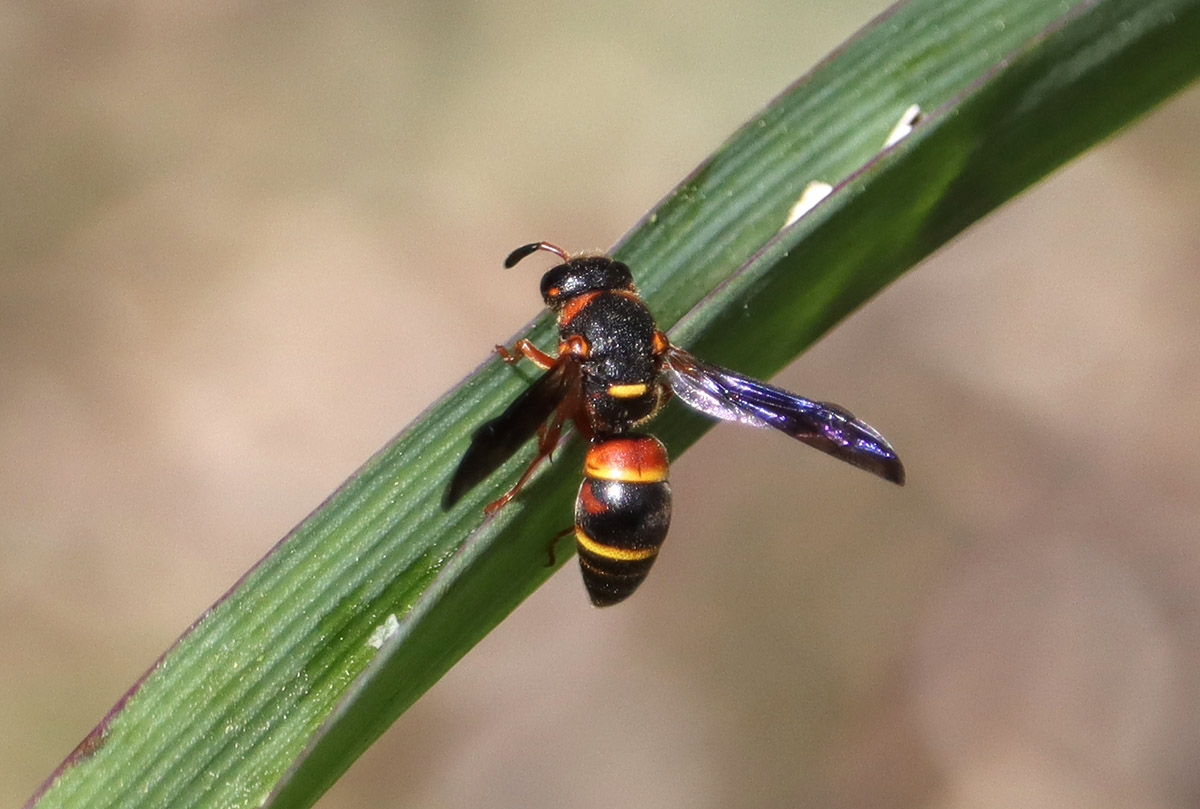
Grand mason wasp (Euodynerus megaera)

This is a species in the foraminatus group, though it can be distinguished from the other more cryptic wasps in the listing above. I saw this one circle around a carpenter bee nest one day, perhaps sealing it with sand and saliva. Carpenter bee nests are often taken over by mason wasps.
Genus Eumenes
Fraternal potter wasp (Eumenes fraternus)
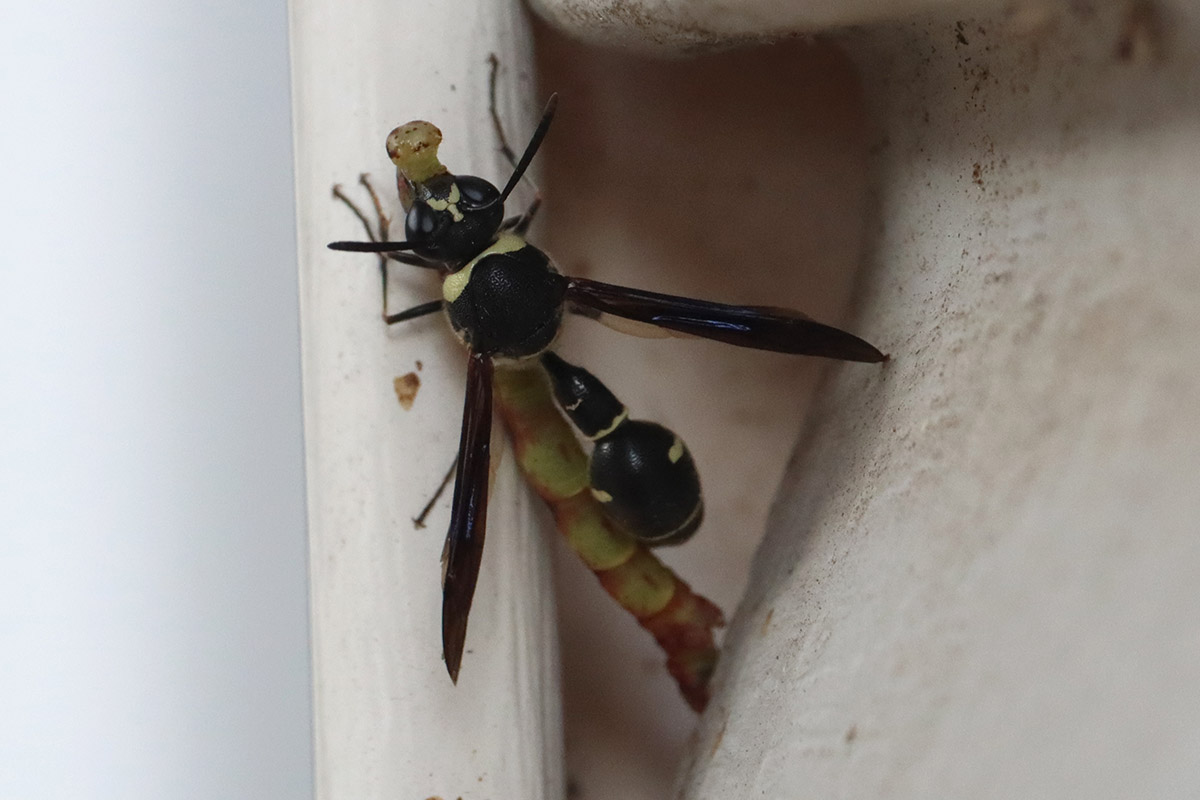
Most of the wasps I see from subfamily Eumeninae in my yard are mason wasps; this is the one potter wasp I see. Below you can see the nests it builds.
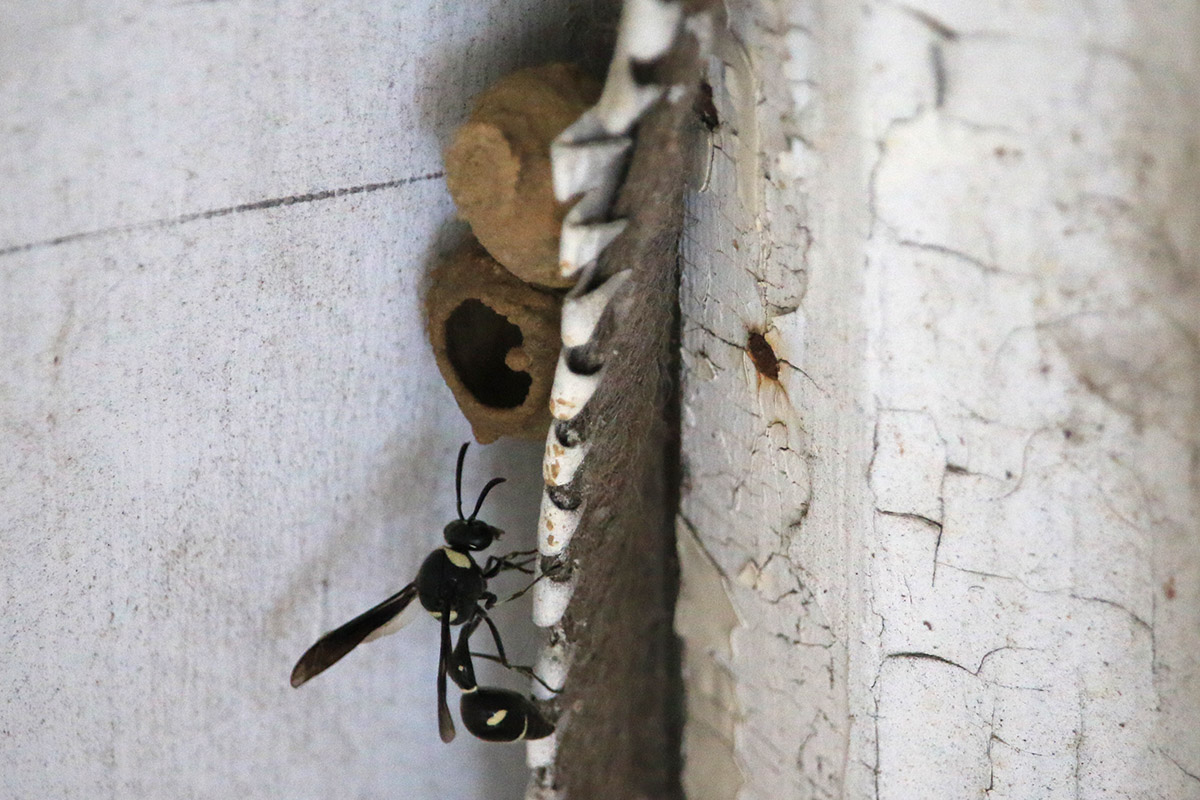
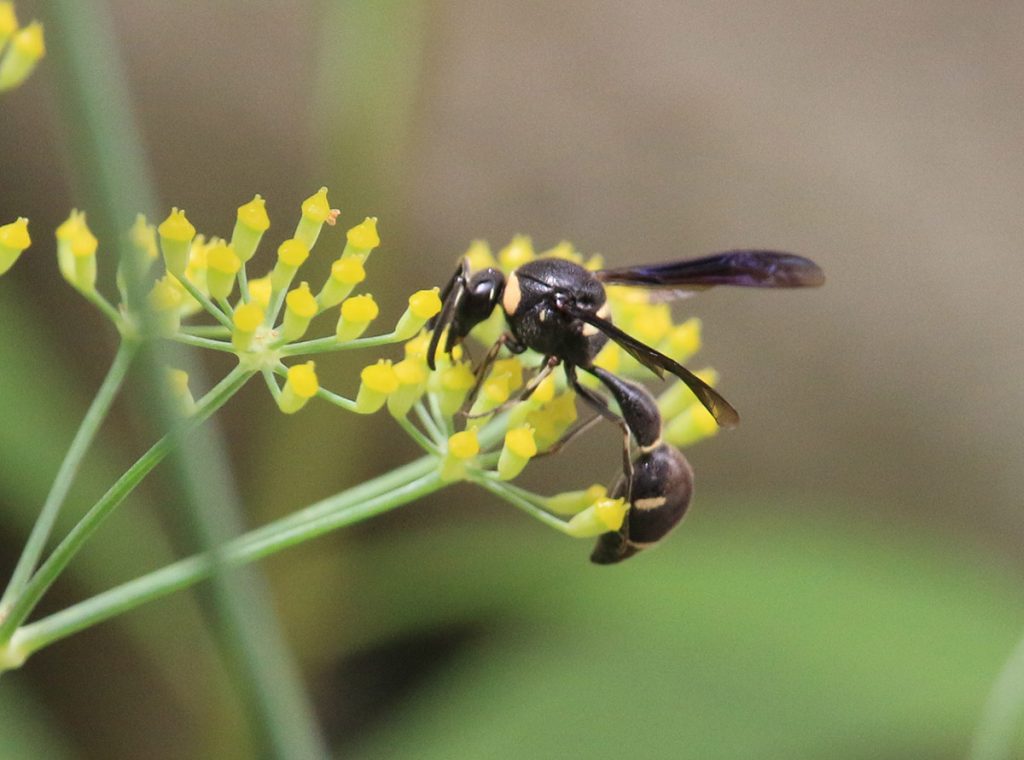
Genus Monobia
Four-toothed mason wasp (Monobia quadridens)
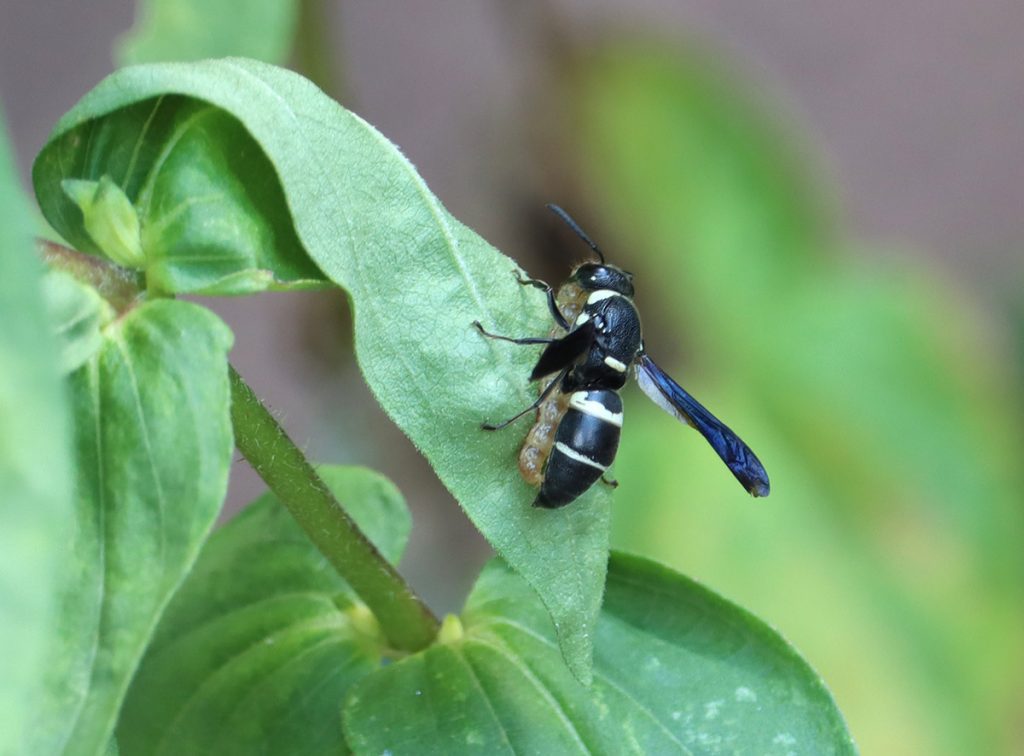
This wasp is common in my yard, always found nesting in abandoned carpenter bee nests, where I often see it bring caterpillars. I also often see Chrysis smaragdula, a cuckoo wasp, near its nest. This wasp specializes in four-toothed mason wasps, replacing some of its eggs with her own, who hatch to eat a caterpillar captured by someone else’s mom.

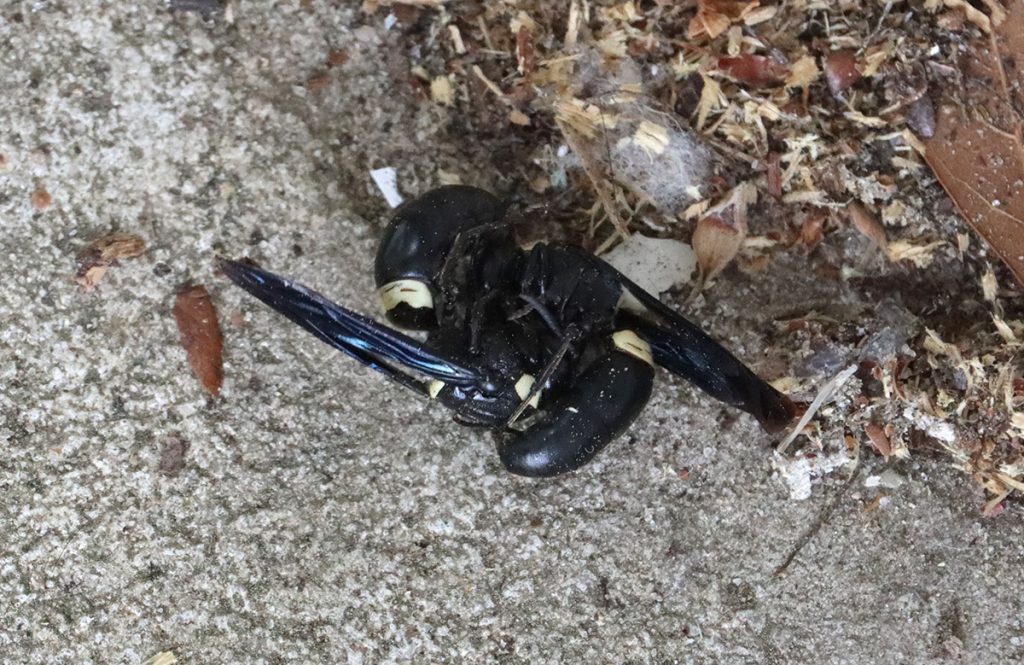
Genus Pachodynerus
Red-marked pachodynerus wasp (Pachodynerus erynnis)

Another common mason wasp in our yard.

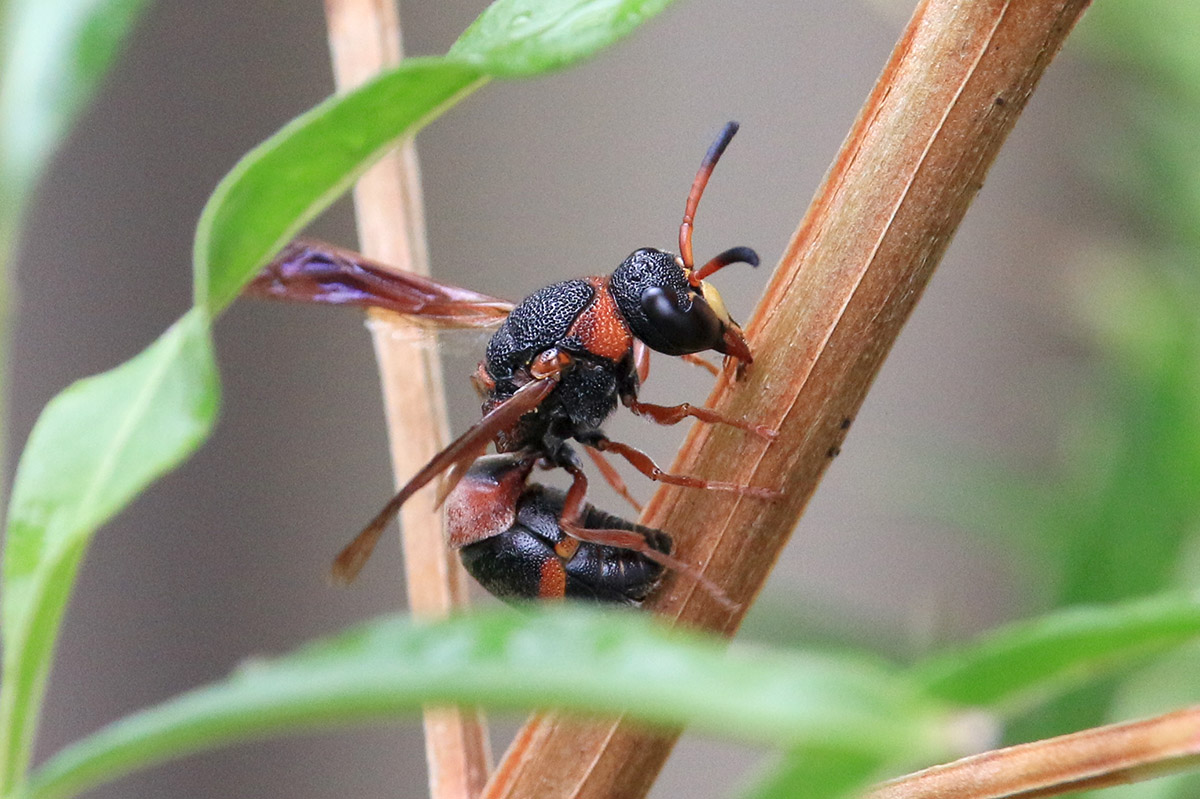
Genus Parancistrocerus
Bugguide has an interesting quote on this genus of wasp from a 1979 study:
“Most species make their nests in abandoned borings of other insects in twigs, stems or wood, in artificial borings in wood, in abandoned mud-dauber nests and insect galls, and in abandoned borings of ground-nesting wasps or bees in the ground. One species constructs multicellular mud nests attached to branches or twigs. The species have been reported as preying only upon larvae of Lepidoptera.”
Catalog of Hymenoptera of North America (Karl Krombein, Paul Hurd, David Smith, and B.D. Burks, 1979)
Parancistrocerus fulvipes

Parancistrocerus perennis
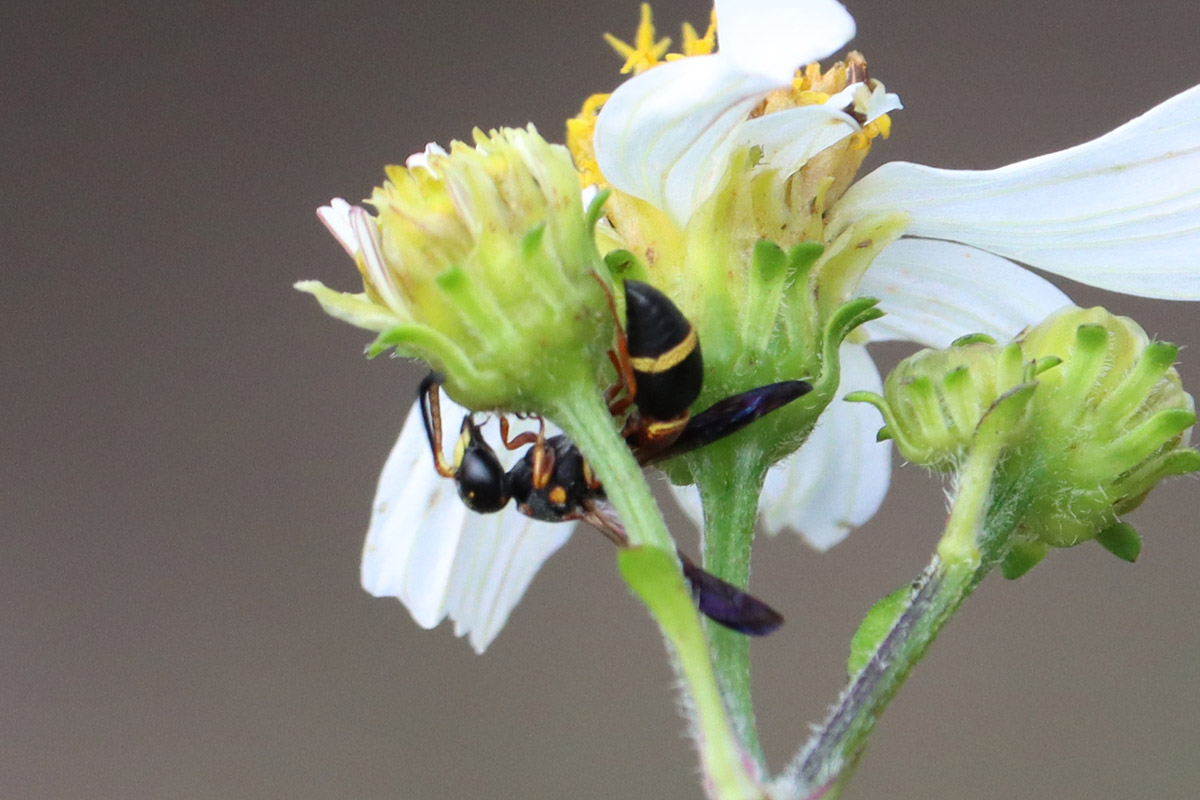
Subfamily Polistinae: Paper Wasps
I strive for biodiversity in the yard, and I usually speak in favor of any native insect in the yard. Some eat the bees I love, or butterfly caterpillars. Survival of the fittest, I say. The next two subfamilies, however, are some of my least favorite insects in the yard. Here we can make a distinction between social nesting insects and solitary nesting insects.

All of the wasps we’ve seen up until now are solitary nesters. Many of them are large, menacing predators. But they’re only really menacing to their prey. They don’t want to mess with us; if they die, they can’t lay eggs on or in their prey. Their line stops. Social nesters are a different story. In a social wasp nest, a queen lays the eggs and workers help raise the young (it’s true of social bees as well), and workers will defend the nest even if it means we squash them as we defend ourselves. It’s why you’re more likely to be stung by a paper wasp, yellow jacket or honey bee than a digger wasp, cicada killer, or leafcutter bee. You’ve likely seen a paper wasp nest on your house and tried to figure out how to knock it down without getting stung (wait until night, when they’re asleep).
And, as we’ll see in the photos, paper wasps are most likely to kill my favorite caterpillar species.
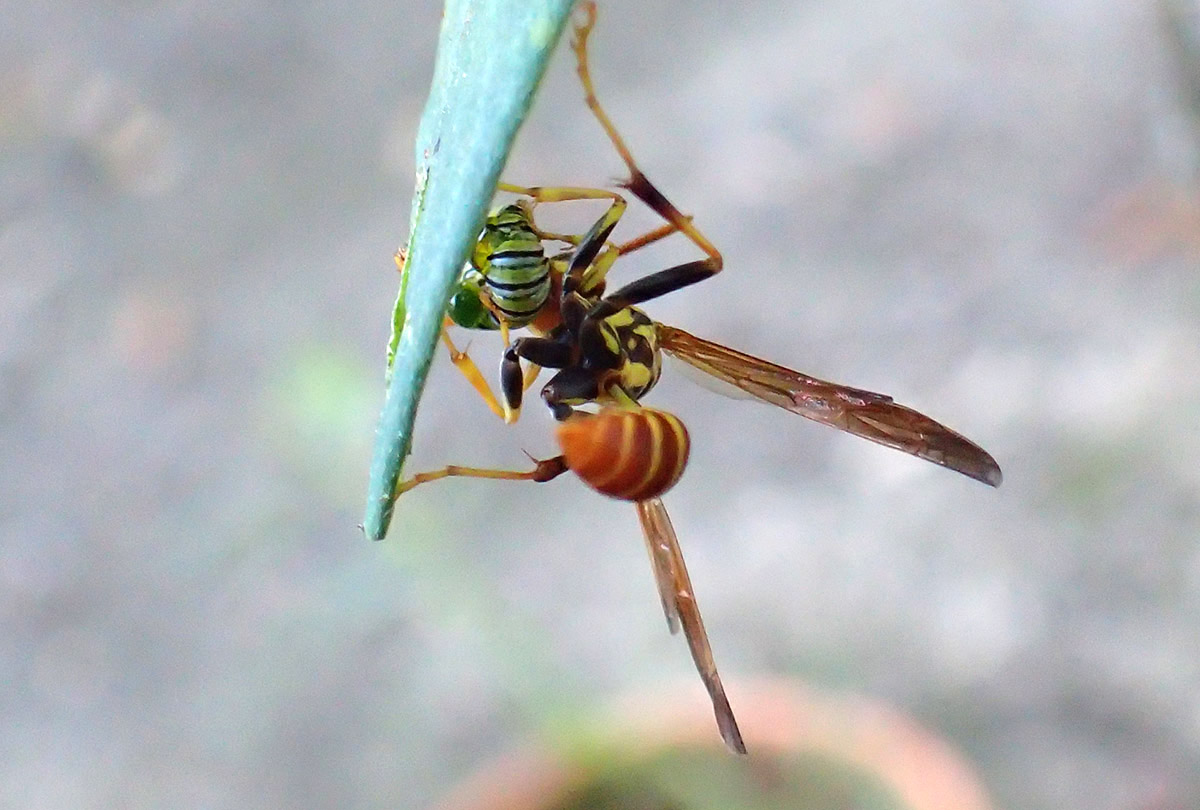
Genus Mischocyttarus
Mexican paper wasp (Mischocyttarus mexicanus)
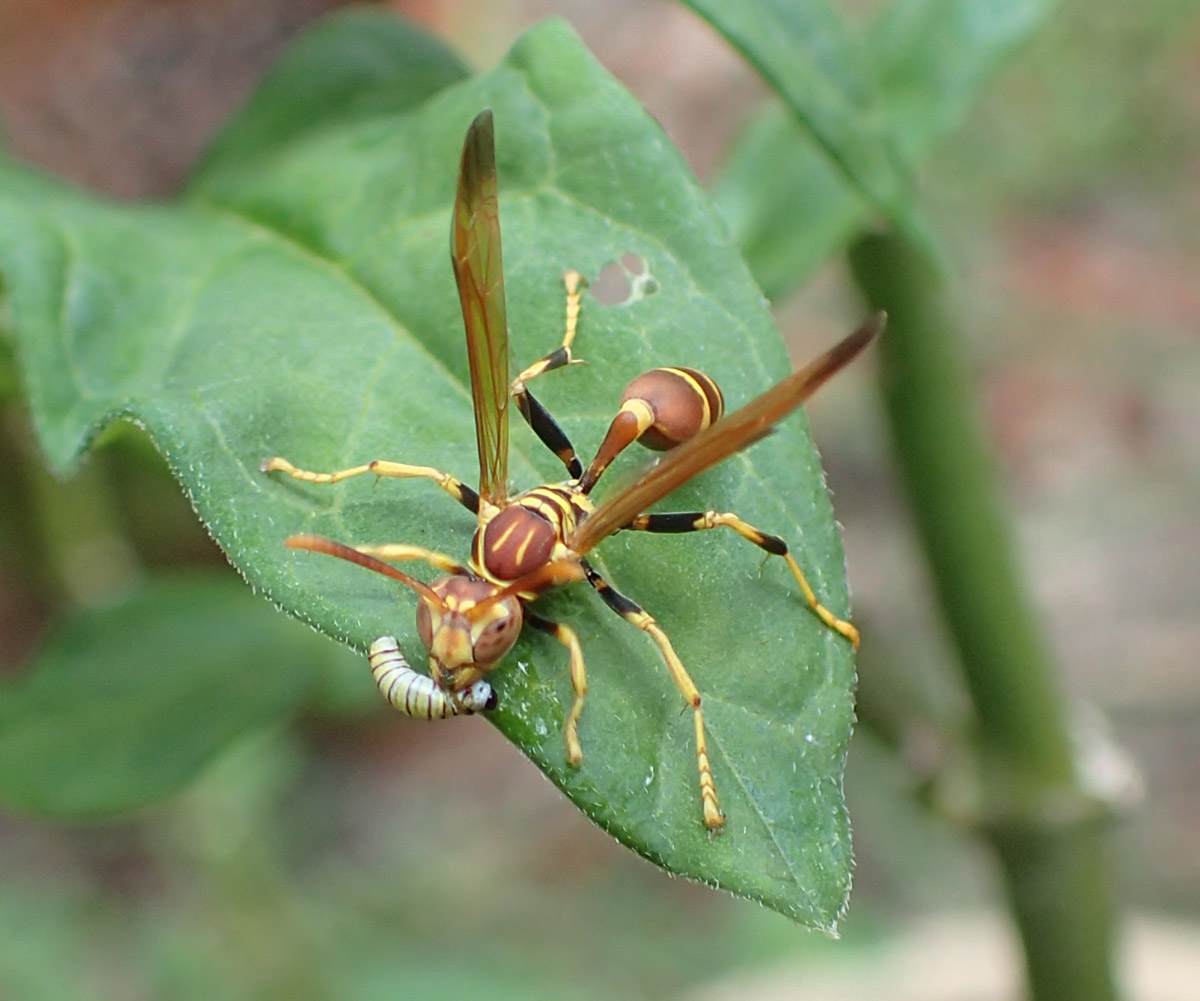
The above is a banner image for a post I wrote on Monarch predators. In the post, I shared research that suggested that we hurt monarchs as a species when we protect them from predators by raising them in enclosures. The monarchs who best evade predators pass on their genes, just as the wasps who successfully provision a nest with caterpillars pass on their genes. It’s part of a process that does not comfort small children when we go out to count caterpillars on our milkweed plants.
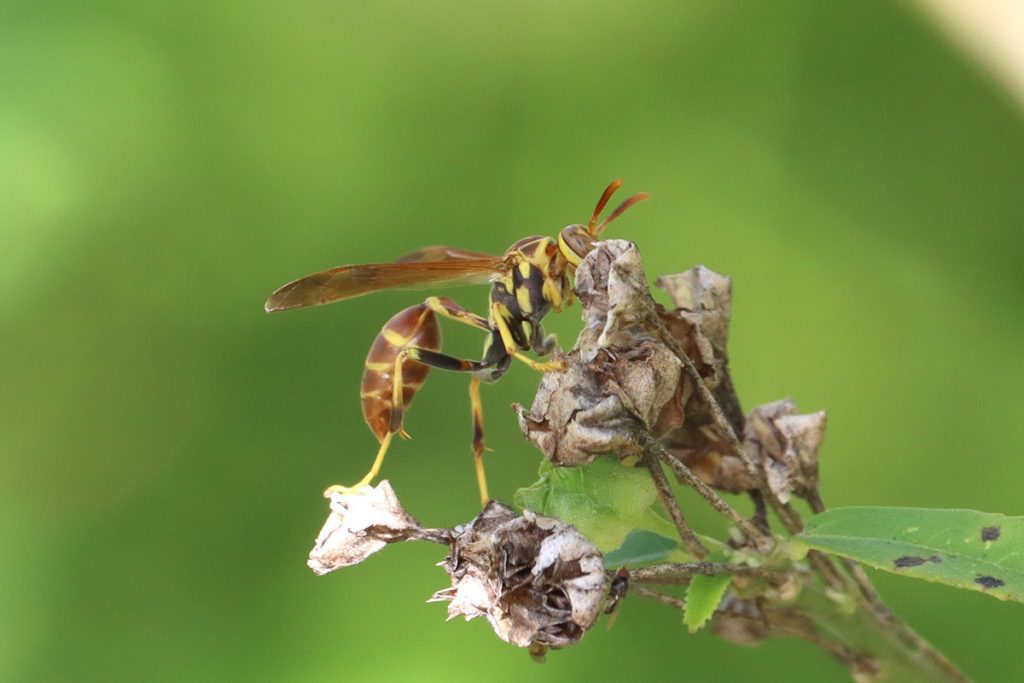
Genus Polistes
Guinea paper wasp (Polistes exclamans)
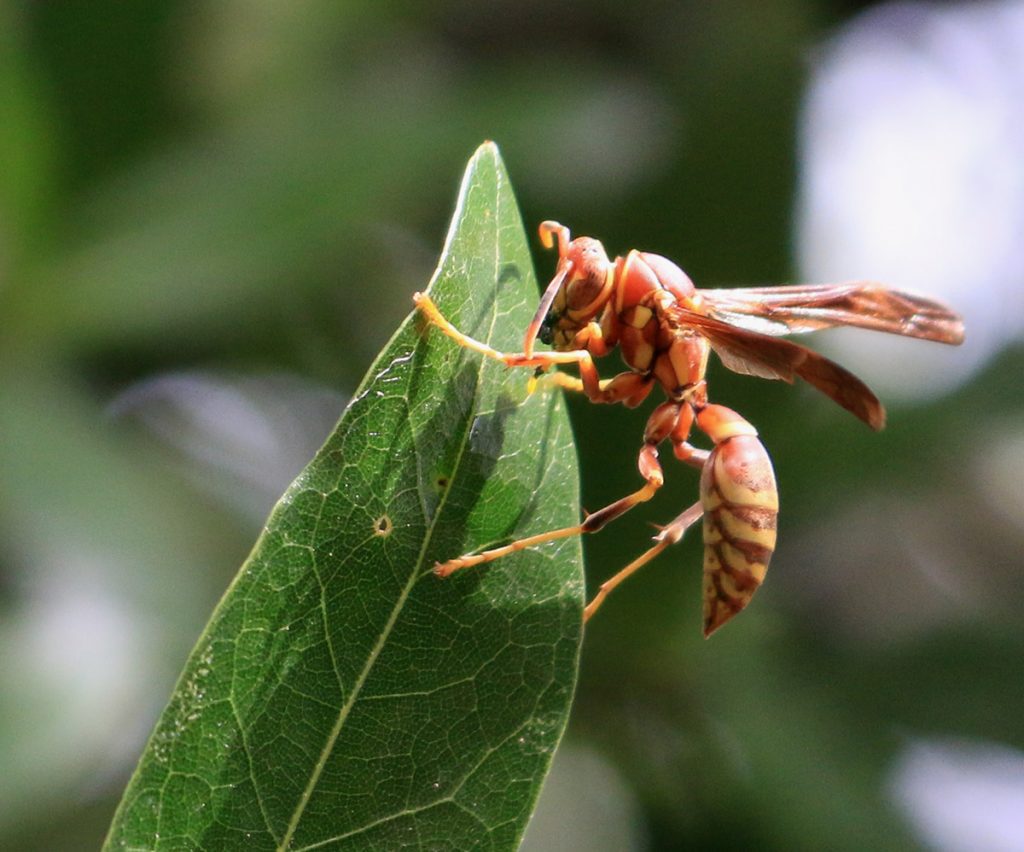
Also known as the common paper wasp.
Horse paper wasp (Polistes major)
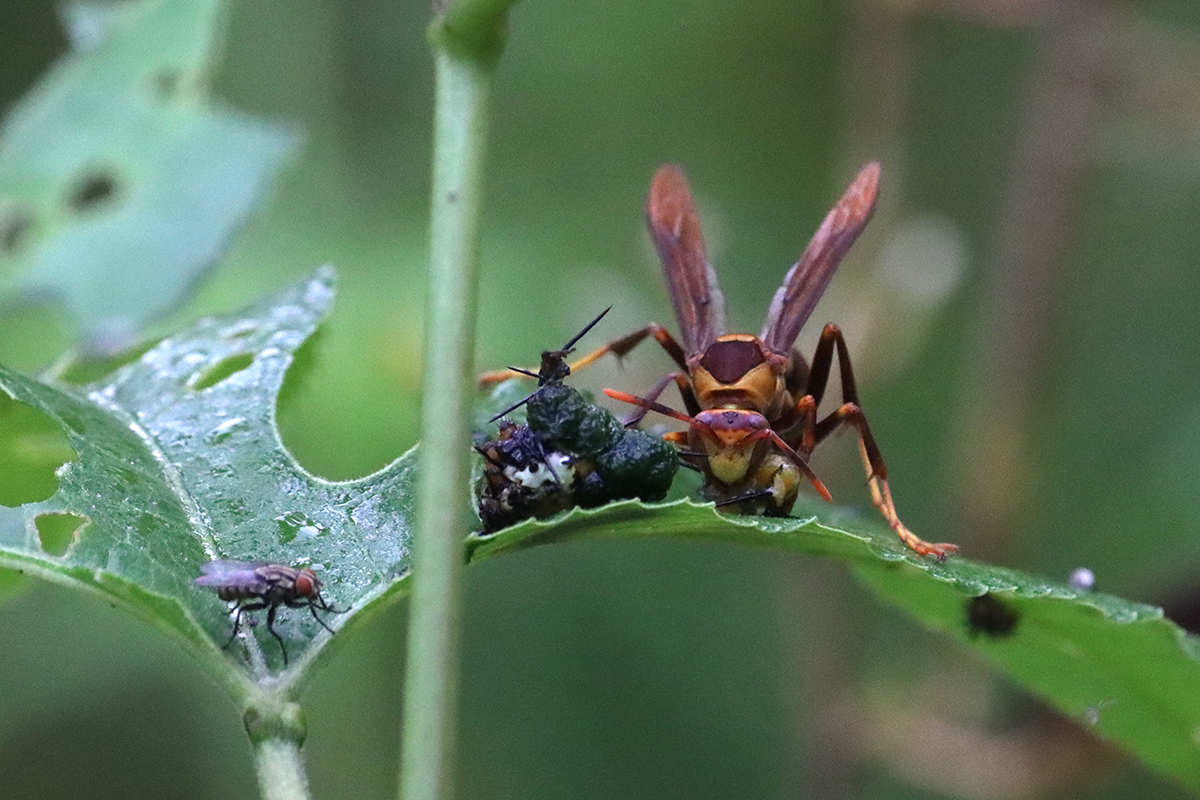
A note on this wasp’s bugguide page led me to research its history in Florida. I found a research paper that looked into its first records in Florida, and there is no record of horse paper wasps here prior to 1958. This could be an introduced species with a native range that extends from Texas to Brazil. It has been in south Florida for a few decades at least, and has been expanding its range northward into south Georgia. Of the handful of iNaturalist observations in Georgia, the oldest is from 2017. Here in Tallahassee, we are towards the northern end of its eastern (possibly nonnative) range.
I first saw this wasp in my yard in 2022, and it is a murderer with a seeming taste for zebra longing caterpillars and adult butterflies. I’m used to seeing wasps take caterpillars, and I’ve seen how other paper wasps will skin a large caterpillar. As I documented in a 2022 blog post, I saw a horse paper wasp attack two mating zebra longwings, carrying off most of the female to bring back to her nest. This wasp is a straight up thug.
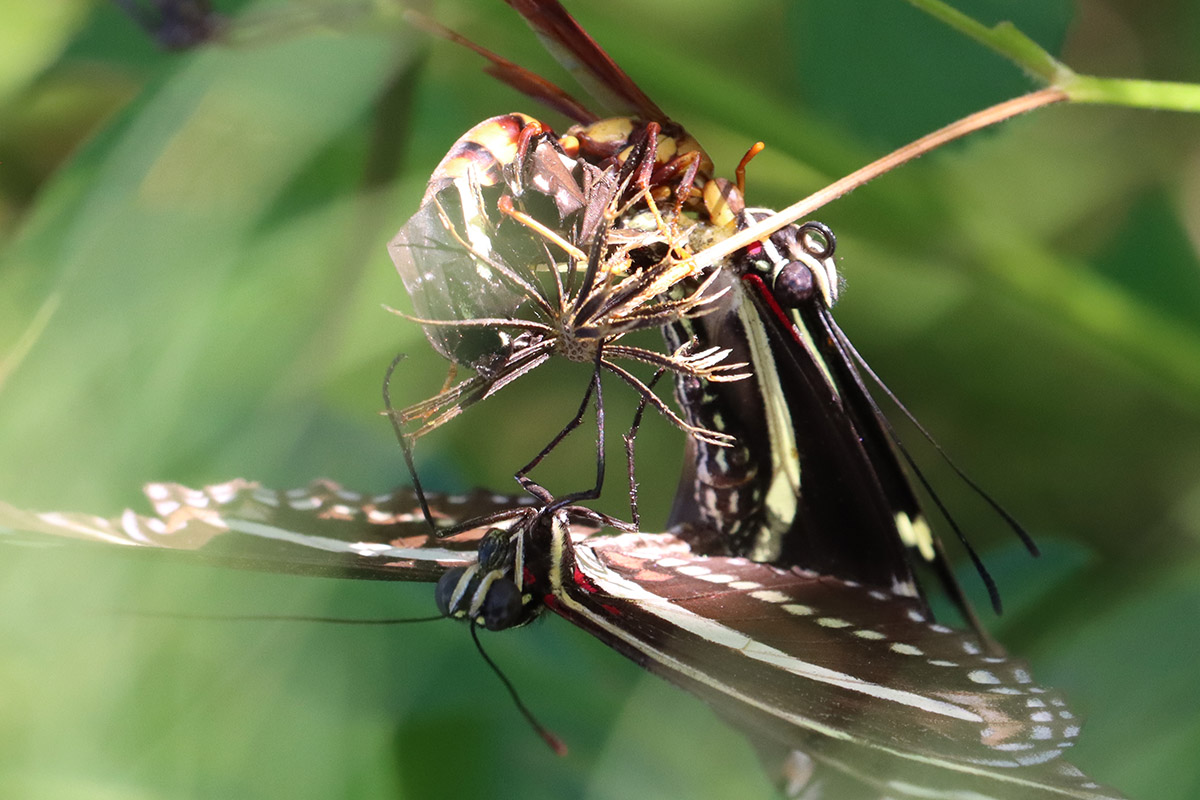
Hunter’s paper wasp (Polistes dorsalis)

Metric paper wasp (Polistes metricus)
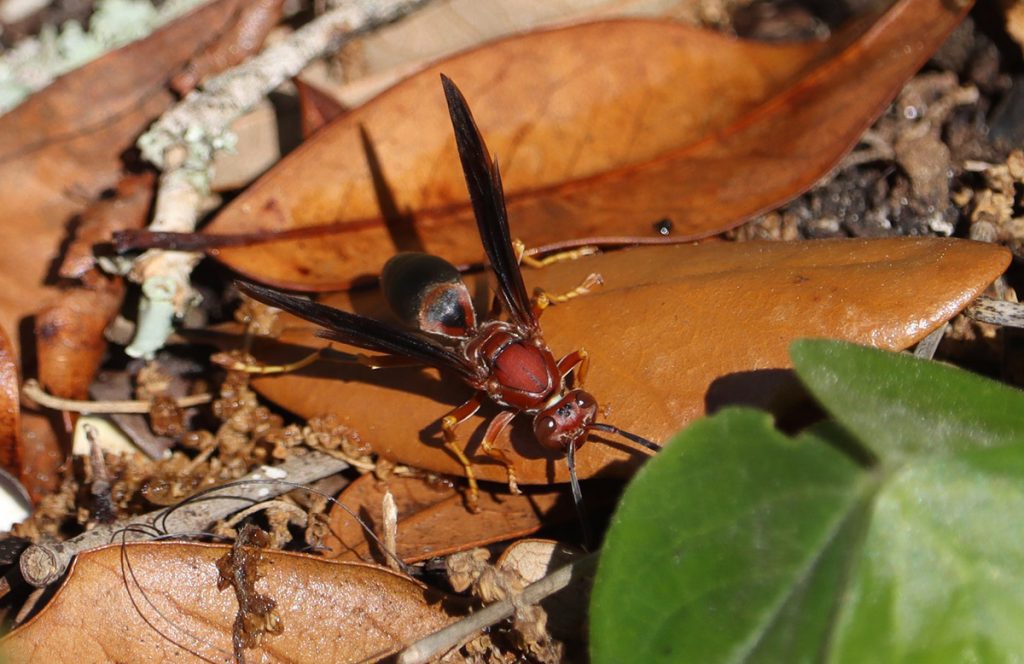
If you want to see one of these wasps skin my favorite kind of caterpillar (a black swallowtail butterfly), you can hop over to this page on raising caterpillars. If you’re asking why I filmed my favorite kind of caterpillar get massacred, well it was already dead, and it’s my job to get that kind of footage. Natural selection and all.
Southern paper wasp (Polistes bellicosus)
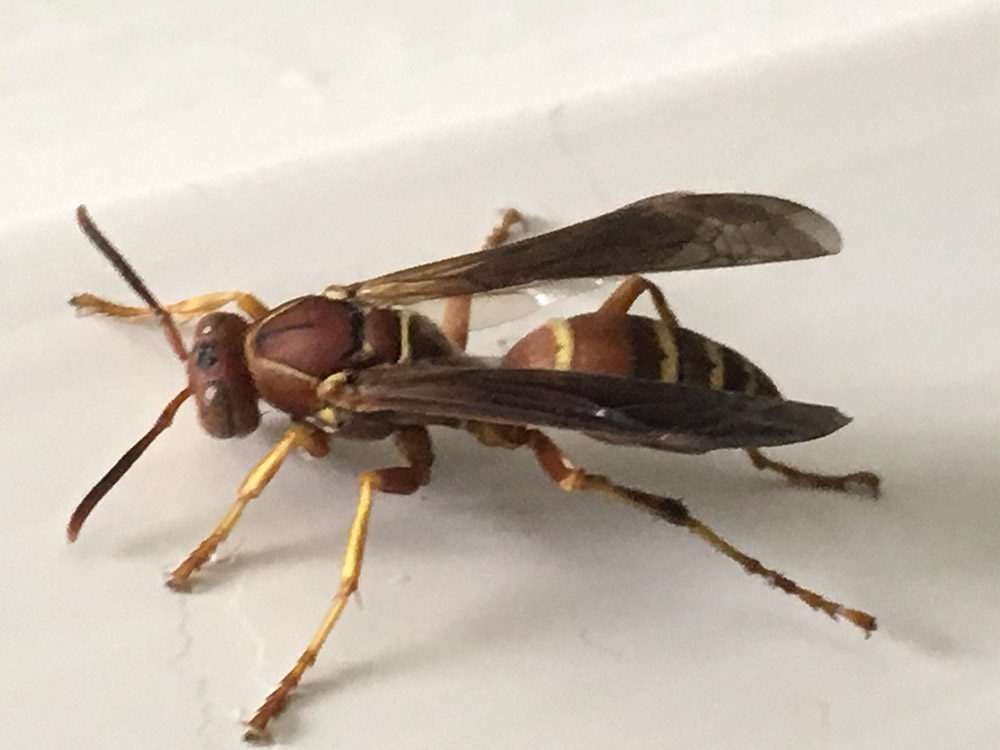
Subfamily Vespinae
Genus Vespula
These are the yellowjackets, possibly the least beloved of all wasps. These are social, ground-nesting insects, and among the most likely to sting a human.
Eastern yellowjacket (Vespula maculifrons)

We, fortunately, have not had a yellowjacket nest in our yard. And yet, I often see eastern yellowjacket queens in the yard over the winter months. She has likely been impregnated, and will hide away the winter. In the spring, she will likely dig down and make a nest somewhere. Somewhere else, hopefully.
Southern yellowjacket (Vespula squamosa)
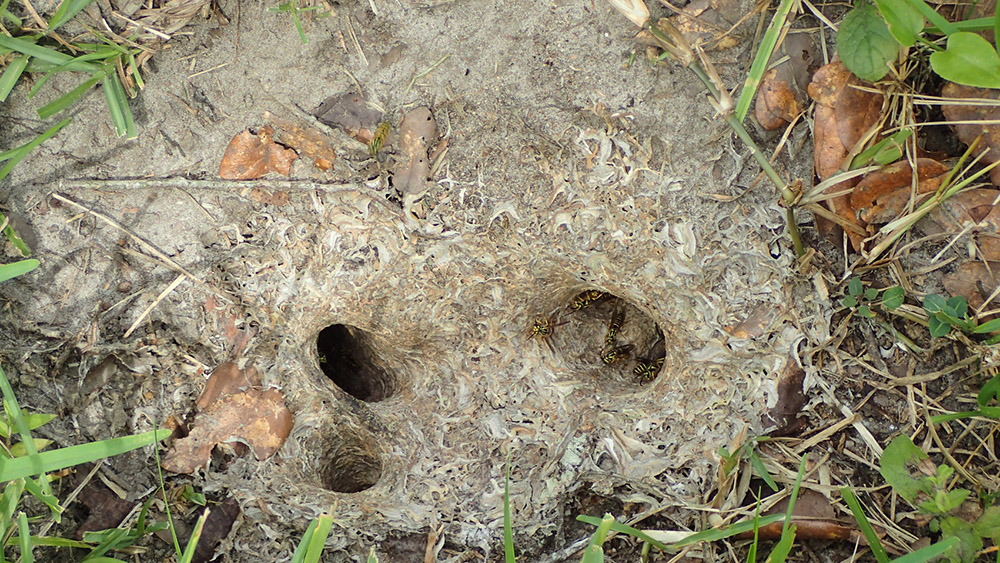
Here we see a yellowjacket nest, photographed at a safe distance with my phone. This species often takes over the nests of other yellowjacket species after its queen moves into an established colony and kills its queen. They’re even nasty to each other.

Family Cynipidae: Gall wasps
I listed the families alphabetically with the exception of gall wasps, because I have no photos of the wasps themselves. And yet, we’ve all seen evidence of them, even if we weren’t aware of it. The more I learn about wasps, the more I’m amazed at the reproductive methods they have evolved. Some inject eggs into prey along with chemicals that shut down the host insect’s development. Others are hunters for their larvae, despite being pollinators as adults, while others violate the nests of other wasp species to replace a few eggs with their own.
Gall wasps reproduce in a way that resembles parasites such as the Braconids and Ichneumons, but they lay their eggs in plants rather than other insects. The chemicals they inject with their eggs restructure the cells of a leaf or stem. Sometimes, the structures keep a wooden texture, and often they don’t resemble their host plant at all.
Tribe Cynipini: Oak Gall Wasps
Genus Amphibolips
Fusiform oak apple gall wasp (Amphibolips acuminata)
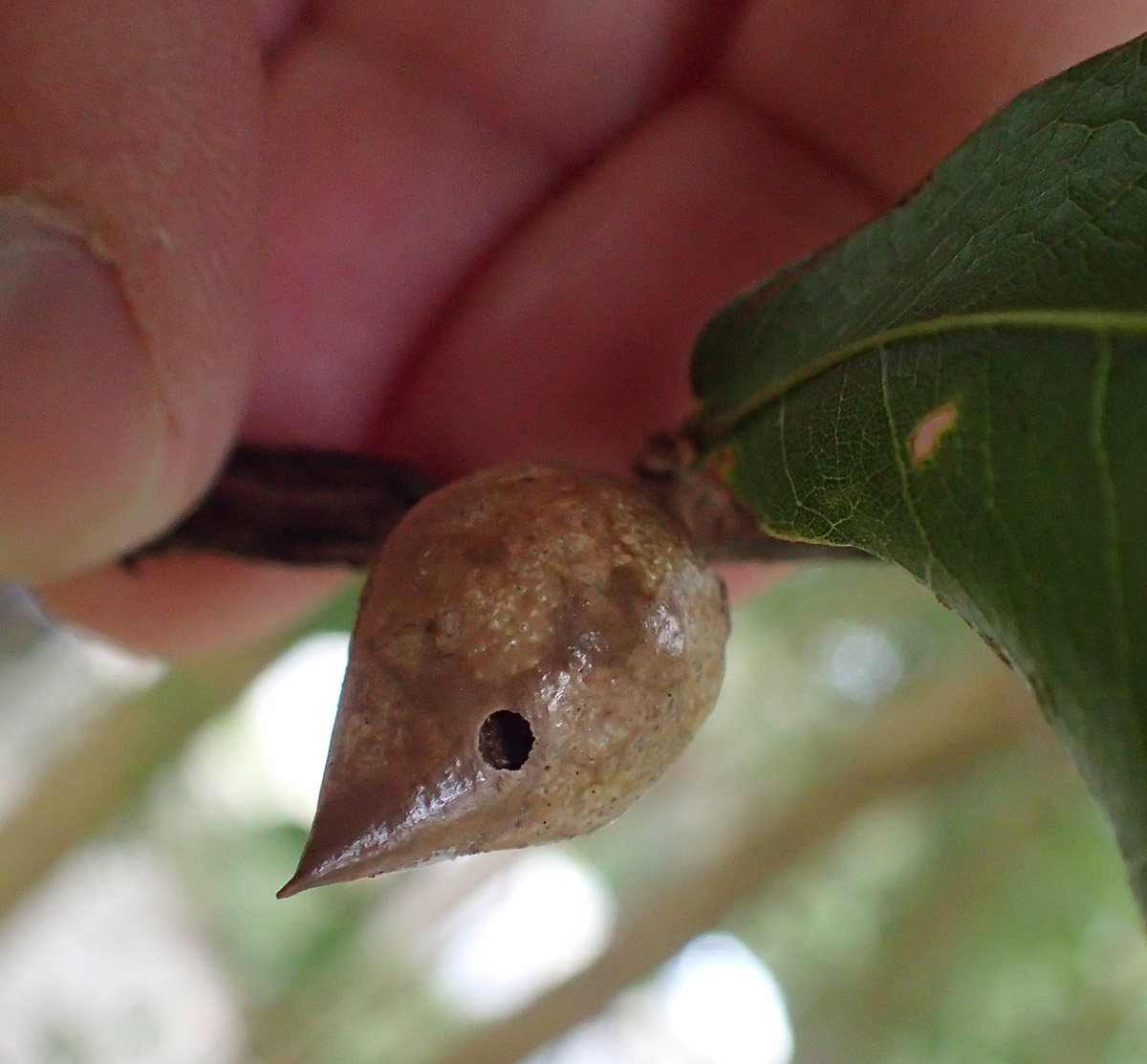
Genus Andricus
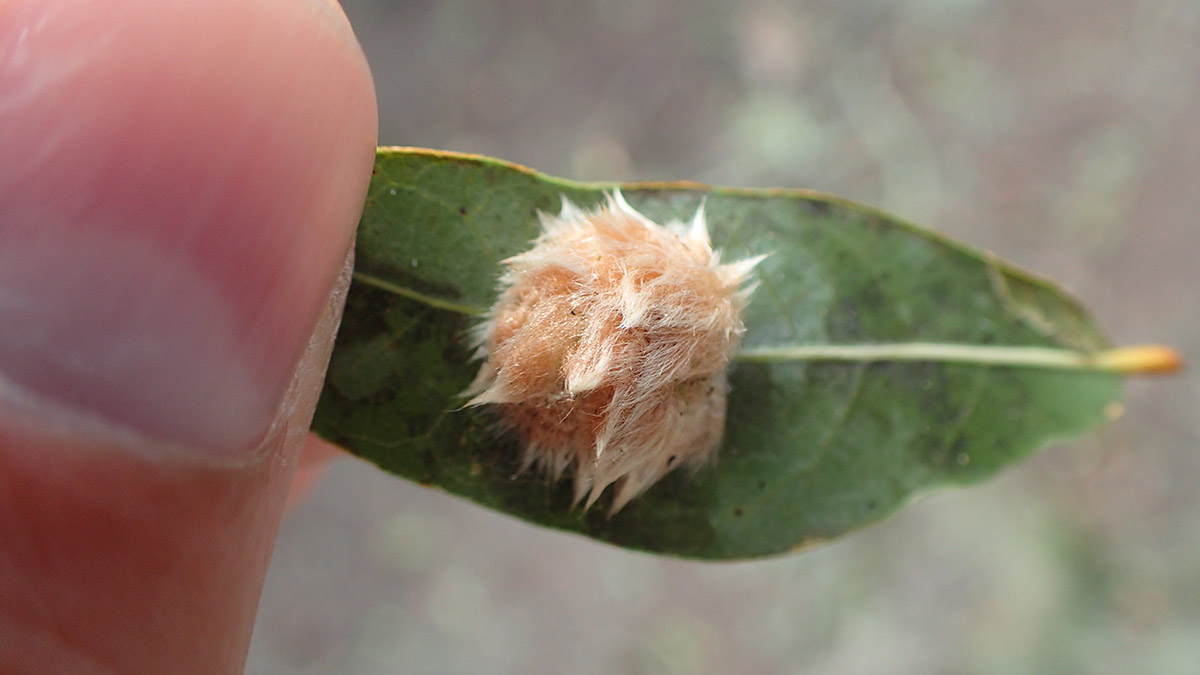
This looks something like a flannel moth, and there is an advantage in mimicking an insect with venomous spines.
Leafy oak gall wasp (Andricus quercusfoliatus)

When I encountered this on the Garden of Eden Trail, I was confused at seeing an oak with what appeared to be flowers like these.
Genus Belonocnema
Belonocnema treatae
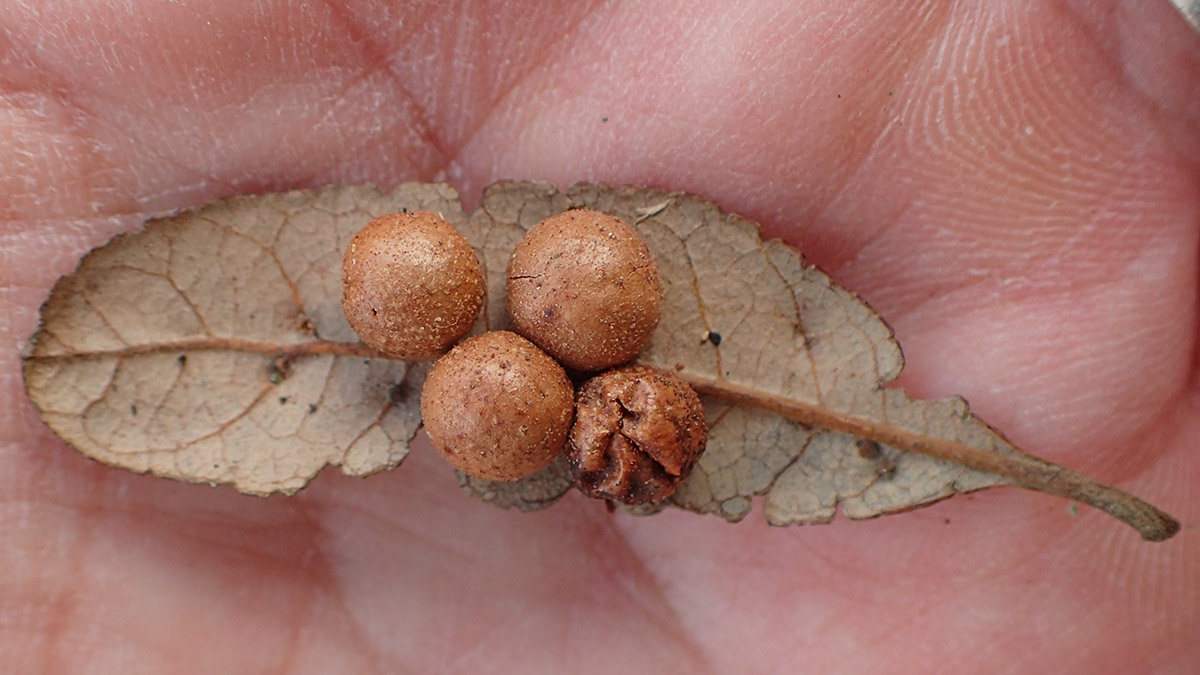
This wasp makes galls on live oak leaves.
Genus Callirhytis
Woolly oak gall wasp (Callirhytis lanata)

Southern live oak stem gall wasp (Callirhytis quercusbatatoides)

Another live oak specialist.
Genus Disholcaspis
Disholcaspis spongiosa
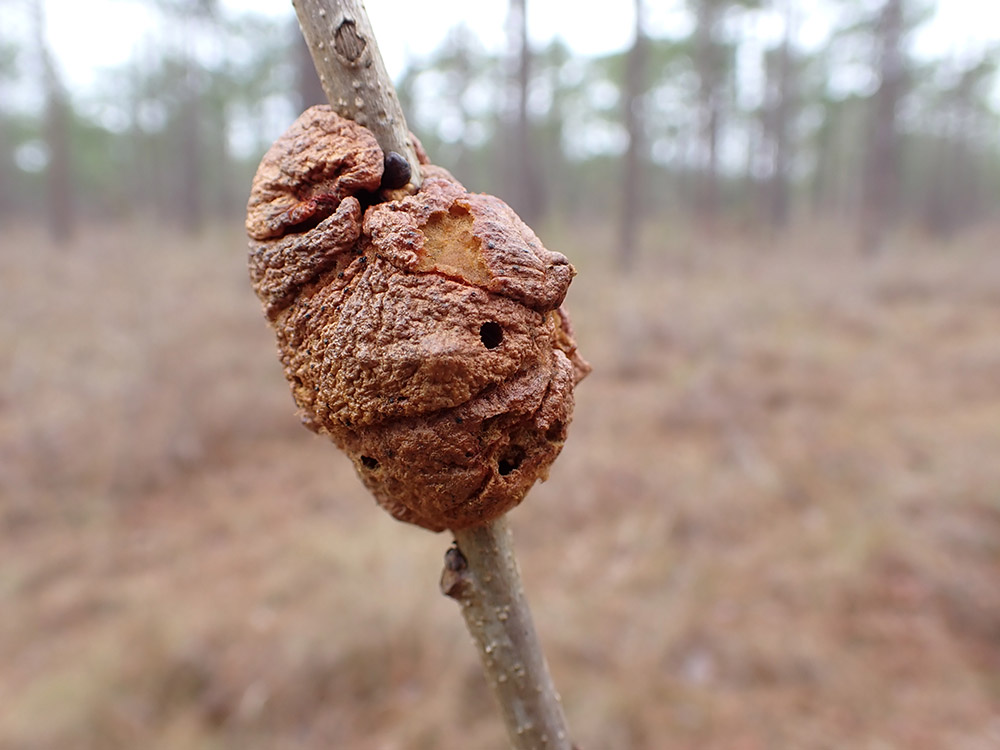
Genus Druon
Wool-bearing gall wasp (Druon quercuslanigerum)

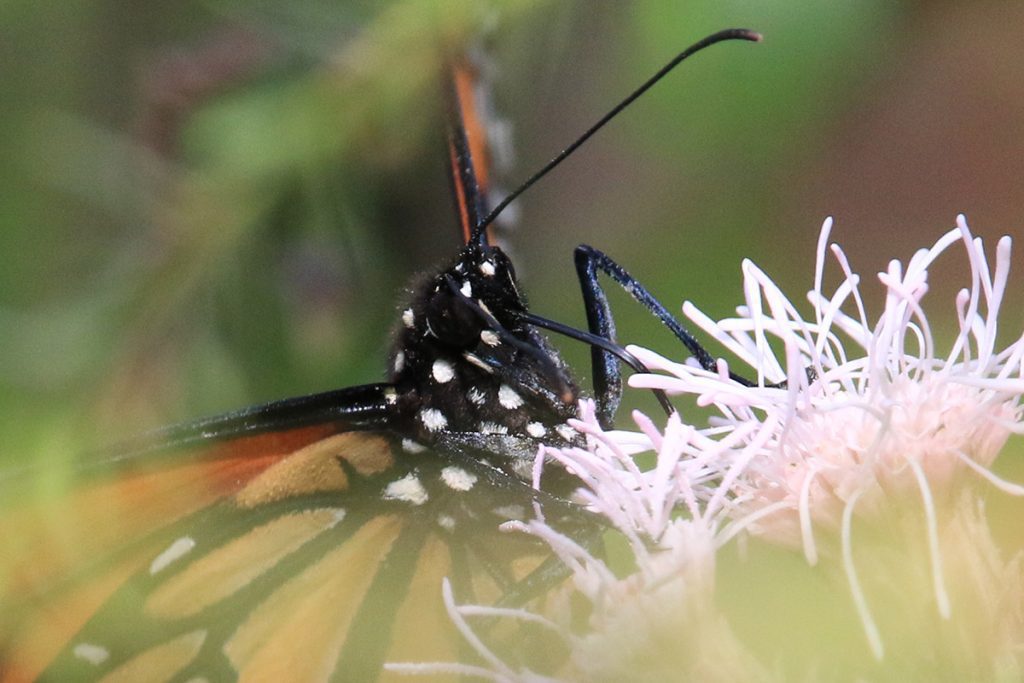
Dig Deeper into Backyard Ecology
What can we do to invite butterflies, birds, and other wildlife into our yards? And what about the flora and fauna that makes its way into our yards; the weeds, insects, and other critters that create the home ecosystem? WFSU Ecology Blog takes a closer look.


